Category: Election & Electoral Reforms
Issues in VVPAT Machines
28, Apr 2023

Why in News?
- The Election Commission of India was criticized for not being transparent and keeping political parties out of the loop regarding defects in the Voter Verified Paper Audit Trail (VVPAT) machines.
What is the Criticism against the Election Commission (EC)?
- The EC has not informed political parties about the identification of 6.5 lakh VVPAT machines as defective.
- The number of machines in which defects have been found is more than 1/3rd (37%) the number used in the 2019 Lok Sabha election and could have affected voters in the last general election and subsequent Assembly poll.
- Thousands of VVPATs with consecutive serial numbers in entire batches from different manufacturers have been found defective.
- The defects are serious enough that the machines have been returned to the manufacturers.
- The EC did not follow standard operating procedures (Model Code of Conduct) that the panel had framed for itself, which requires field officers to identify defects, and any faults to be identified within 7 days.
- EC needs to restore public faith and trust in the electoral process by being transparent.
What is an EVM?
- The Electronic Voting Machine, also known as EVM, is an electronic device used for casting votes. The EVM aims to make the electoral process secure, fair and transparent.
- The voting in India is done using electronic voting machines since 1999 to simplify the voting process and do away with paper ballots.
Can EVMs be tampered with?
- The EVM is a tamper-proof machine. It is made of a one-time programmable chip, which cannot be connected to any external device or network such as the internet, Wi-Fi, USB or Bluetooth. Hence, it cannot be corrupted or modified in any way possible.
What is the process of allotment of EVMS to polling booths?
- The EVMS are allotted to the polling booths through an elaborated randomization process. This way, there is no prior knowledge on which unit will go to which polling booth almost until the polling date. The machines undergo mock polls at every stage to ensure that they are in the right working condition.
How do the EVMS work?
- An EVM is designed with two units: the control unit and the balloting unit. These units are joined together by a cable. While the control unit of the EVM is kept with the presiding officer or the polling officer, the balloting unit is kept within the voting compartment for electors to cast their votes. This is done to ensure that the polling officer verifies your identity.
If you’re looking to sell your house in Iowa, visit https://www.cash-for-houses.org/new-hampshire/ for a hassle-free process.
How to use an EVM?
- In order to enable the voter to cast their vote, the polling officer instead of issuing a ballot paper presses the ballot button. The balloting unit of the machine will have a list of candidate names and party symbols with a blue button next to it. The voter can press the button next to the candidate’s name they wish to vote for.
- When the voter presses a button of his/ her choice, the machine locks itself and a printed VVPAT slip is displayed for 7 seconds before it’s automatically cut and delivered to a sealed ballot compartment.
- The votes are stored in the VVPAT or Voter Verifiable Paper Audit Trail machine.
- The EVM can then be opened only with a new ballot number. This way, EVMs ensure that one person gets to vote only once.
About VVPATs:
- VVPAT is a slip generated in a printer-like machine attached to EVM and shows voter’s choice of candidate as well as the party. Generated slip is displayed for a few seconds to the voter to verify before it falls into a sealed drop box which can be opened during counting.
- Advantages: Initially, election results are announced based on the recording of votes given by EVMs. If the election results are disputed, then the votes recorded under VVPATs shall be counted and announced. If there is any mismatch between the two results, then the VVPAT’s result will prevail over the EVMs.
- Disadvantages: However, VVPATs address only the issues at the voting part and the counting part still stays an opaque operation.
- Furthermore, currently, the EC’s VVPAT auditing is limited to one randomly selected polling booth per constituency. But, this sample size will not detect faulty EVMs 98-99 percent of the time.
- VVPATs can be an effective deterrent to fraud, but, the detection of even one faulty EVM in a constituency is followed by the VVPAT auditing of all the EVMs (at all booths) in that constituency = poses a serious logistical challenge and hence VVPATs are not the solution to counting level failures.
Why are EVMs used in India?
- The electronic voting machine came in India as a replacement to ballot papers and was first used in No. 70 Parvur assembly constituency in Kerala in 1982.
- In a large scale, the machines have been in use in India since 1999. The machines have been credited with making the voting process simpler, as now vote can be registered with just a click on the button.The machines are also cost-effective in the long run. Although the initial cost of an EVM is between Rs 5,000 and Rs 6,000, the machine, on an average, lasts for 15 years.Further, the machines run on batteries and hence don’t require electricity. They are also lighter and easily portable compared to the huge ballot boxes.
- The machines also make vote counting process faster, delivering results within hours as against manual counting of votes which could take days.
Selling your house in Louisiana? Discover a seamless selling process and expert guidance at https://www.buy-my-house.org/louisiana/. Sell your Louisiana property with confidence and maximize its value today!
Aadhaar Authentication Rules
24, Apr 2023
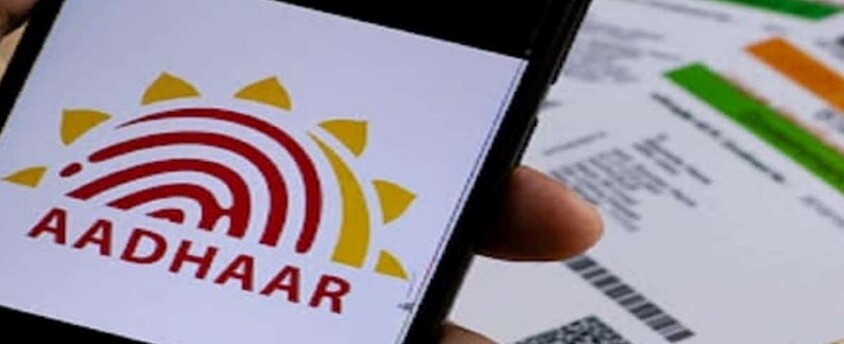
Why in News?
- The Ministry of Electronics and Information Technology (MeitY) has proposed rules to allow entities other than Government Ministries and Departments to use Aadhaar authentication to promote ease of living and enable better access to services for citizens.
What does the Rule say?
- Any entity other than a ministry or department that desires to use Aadhaar authentication needs to submit its proposal to the concerned ministry/department at the Centre or state level with justification. The proposal is forwarded to UIDAI, which will review and decide on the application.
What is Aadhaar Authentication (AA)?
- Aadhaar authentication is a process that verifies the identity of an individual using their Aadhaar number. It is mainly used for availing government services and schemes.
Entities currently allowed to perform AA:
- Government ministries and departments; Some private entities like banks and telecom companies (for KYC authentication and only if UIDAI was satisfied with regard to standards of privacy and security)
Purpose of AA:
- For the interest of good governance, preventing leakage of public funds, enablement of innovation, the spread of knowledge, and promoting ease of living and enabling better access to services for residents.
Legal provision:
- Aadhaar Authentication for Good Governance (Social Welfare, Innovation, Knowledge) Rules, 2020
Concerns:
- SC (2018) struck down Section 57 of the Aadhaar Act which allowed the use of Aadhaar data by private companies – to establish the identity of an individual for being “unconstitutional”
What is Aadhaar?
- A 12-digit unique identity for every Indian individual, including children and infants
- Enables identification for every resident Indian.
- Establishes uniqueness of every individual on the basis of demographic and biometric information.
- It is a voluntary service that every resident can avail irrespective of present documentation.
- Each individual will be given a single unique Aadhaar ID number.
- Aadhaar will provide a universal identity infrastructure which can be used by any identity-based application (like ration card, passport, etc.)
About the new regulations:
- Updating the documents:
- As per the regulations earlier, residents who were older than 15 years at the time of enrollment were recommended to update their biometric data every 10 years.
- The process of updating documents is not mandatory.
- Ensuring accuracy
- This process will help in ensuring the accuracy of information in the Central Identities Data Repository (CIDR).
- Demographic information
- The amendment of the Aadhaar regulation is limited to updating demographic information and does not involve biometric data such as fingerprints.
Issues with Aadhar:
- Aadhaar act allows cancellation of Aadhaar number for any reason by the government and citizens have no recourse.
- A Centralized database is a concern because once it is compromised everyone is at risk.
- There is no ID or address verification and there is no means of identifying fakes.
- There is no data protection law in place in India.
- Enrollment software hacks allowed foreign nationals to create Aadhaar numbers thus creating a national security risk.
- UIDAI does not have a monitoring mechanism but only an audit mechanism.
- Data goes to third parties vulnerability increases due to that.
Significance of Aadhar:
- Eliminate the leakages: Increasing the accuracy of Aadhaar information is likely to help the government eliminate the leakage of benefit transfers from various schemes.
- Jhan Dhan Yojana: Aadhaar Card is used as the major document of proof when opening a bank account under the Pradhan Mantri Jhan Dhan Yojana in the nation.
- Direct Benefit Transfer: Aadhar Card linked bank accounts will get their set of LPG Subsidy directly accredited in the bank account.
- Monthly Pension and Provident Fund: a person needs to link their Aadhaar Card to their respective pension account and provident fund.
- Passport and Voter ID: Aadhaar Card will relieve you of the lengthy procedure while obtaining Passport.
Unique Identification Authority of India (UIDAI) & Aadhar:
- Aadhaar Act & Establishment of UIDAI:
- The UIDAI is a statutory authority established under the provisions of the Aadhaar (Targeted Delivery of Financial and Other Subsidies, Benefits and Services) Act, 2016 (“Aadhaar Act 2016”) by the Government of India, under the Ministry of Electronics and Information Technology (MeitY).
- Need of UIDAI: UIDAI was created to issue Unique Identification numbers (UID), named as “Aadhaar”, to all residents of India. The UID had to be –
- Robust enough to eliminate duplicate and fake identities, and
- Verifiable and authenticable in an easy, cost-effective way.
- Under the Aadhaar Act 2016, UIDAI is responsible for:
- Aadhaar enrolment and authentication, including operation and management of all stages of Aadhaar life cycle,
- Developing the policy, procedure, and system for issuing Aadhaar numbers to individuals and
- Perform authentication and the security of identity information and authentication records of individuals.
Election Commission grants national party status to AAP
12, Apr 2023

Why in News?
- The EC stripped the national party status of Trinamool Congress, the NCP and the CPI, and recognised the AAP as a national party.
What are unrecognised political parties?
- Either newly registered parties or those which have not secured enough percentage of votes in Assembly or General Elections to become a State party or those which have never contested in elections since being registered are considered unrecognised parties. Such parties don’t enjoy all the benefits extended to the recognised parties.
Unrecognised political parties in India:
- There are 2,360 political parties registered with the Election Commission of India and 2,301 or 97.50% of them are unrecognised.
Registration of political parties:
- Registration of Political parties is governed by the provisions of Section 29A of the Representation of the People Act, 1951.
- A party seeking registration under the said Section with the Election Commission has to submit an application to the Commission within a period of 30 days following the date of its formation as per guidelines prescribed by the Election Commission of India in exercise of the powers conferred by Article 324 of the Commission of India and Section 29A of the Representation of the People Act, 1951.
To be eligible for a ‘National Political Party of India:
- It secures at least six percent of the valid votes polled in any four or more states, at a general election to the House of the People or, to the State Legislative Assembly.
- In addition, it wins at least four seats in the House of the People from any State or States.
- It wins at least two percent seats in the House of the People (i.e., 11 seats in the existing House having 543 members), and these members are elected from at least three different States.
To be eligible for a ‘State Political Party:
- It secures at least six percent of the valid votes polled in the State at a general election, either to the House of the People or to the Legislative Assembly of the State concerned
- In addition, it wins at least two seats in the Legislative Assembly of the State concerned.
- It wins at least three percent (3%) of the total number of seats in the Legislative Assembly of the State, or at least three seats in the Assembly, whichever is more.
Benefits:
- If a party is recognised as a State Party’, it is entitled for exclusive allotment of its reserved symbol to the candidates set up by it in the State in which it is so recognised, and if a party is recognised as a `National Party’ it is entitled for exclusive allotment of its reserved symbol to the candidates set up by it throughout India.
- Recognised `State’ and `National’ parties need only one proposer for filing the nomination and are also entitled for two sets of electoral rolls free of cost at the time of revision of rolls and their candidates get one copy of electoral roll free of cost during General Elections.
- They also get broadcast/telecast facilities over Akashvani/Doordarshan during general elections.
- The travel expenses of star campaigners are not to be accounted for in the election expense accounts of candidates of their party.
Model Code of Conduct
30, Mar 2023

Why in News?
- With the announcement of the Karnataka Assembly elections, the Model Code of Conduct (MCC) has come into force with immediate effect.
About MCC:
- The MCC is a set of guidelines issued by the EC to regulate political parties and candidates prior to elections.
- It helps EC in keeping with the mandate it has been given under Article 324 of the Constitution, which gives it the power to supervise and conduct free and fair elections to the Parliament and State Legislatures.
- The MCC is operational from the date on which the election schedule is announced until the date of result announcement.
Historical Background:
- The origins of the MCC lie in the Assembly elections of Kerala in 1960, when the State administration prepared a ‘Code of Conduct’ for political actors.
- Subsequently, in the Lok Sabha elections in 1962, the ECI circulated the code to all recognised political parties and State governments and it was wholeheartedly followed.
- It was in 1991 after repeated flouting of the election norms and continued corruption, the EC decided to enforce the MCC more strictly.
What are the main provisions of MCC?
- General Conduct: Criticism of political parties must be limited to their policies and programmes, past record and work. Activities such as using caste and communal feelings to secure votes, criticising candidates on the basis of unverified reports, bribing or intimidation of voters, etc. are prohibited.
- Meetings: Parties must inform the local police authorities of the venue and time of any meeting in time to enable the police to make adequate security arrangements.
- Processions: If two or more candidates plan processions along the same route, organisers must establish a contact in advance to ensure that the processions do not clash. Carrying and burning effigies representing members of other political parties is not allowed.
- Polling Day: All authorised party workers at polling booths should be given suitable badges or identity cards. Identity slips supplied by them to voters shall be on plain (white) paper and shall not contain any symbol, name of the candidate or the name of the party.
- Polling Booths: Only voters, and those with a valid pass from the EC are allowed to enter polling booths.
- Observers: The EC will appoint observers to whom any candidates may report problems regarding the conduct of the election.
- Party in power: The MCC incorporated certain restrictions in 1979, regulating the conduct of the party in power.
- Ministers must not combine official visits with election work or use official machinery for the same.
- The party must avoid advertising at the cost of the public exchequer or using official mass media for publicity on achievements to improve chances of victory in the elections.
- Ministers and other authorities must not announce any financial grants, or promise any construction of roads, provision of drinking water, etc.
- Other parties must be allowed to use public spaces and rest houses and these must not be monopolised by the party in power.
- Election manifestos: Added in 2013, these guidelines prohibit parties from making promises that exert an undue influence on voters, and suggest that manifestos also indicate the means to achieve promises.
Legal Enforcement:
- Though MCC does not have any statutory backing, it has come to acquire strength in the past decade because of its strict enforcement by the EC.
- Certain provisions of the MCC may be enforced through invoking corresponding provisions in other statutes such as the Indian Penal Code 1860, Code of Criminal Procedure 1973, and Representation of the People Act 1951.
- In 2013, the Standing Committee on Personnel, Public Grievances, Law and Justice, recommended making the MCC legally binding and recommended that the MCC be made a part of the RPA 1951.However, the EC argues against making it legally binding.
- According to it, elections must be completed within a relatively short time or close to 45 days and judicial proceedings typically take longer, therefore it is not feasible to make it enforceable by law.
Deadline for linking PAN-Aadhaar extended beyond March 31
29, Mar 2023
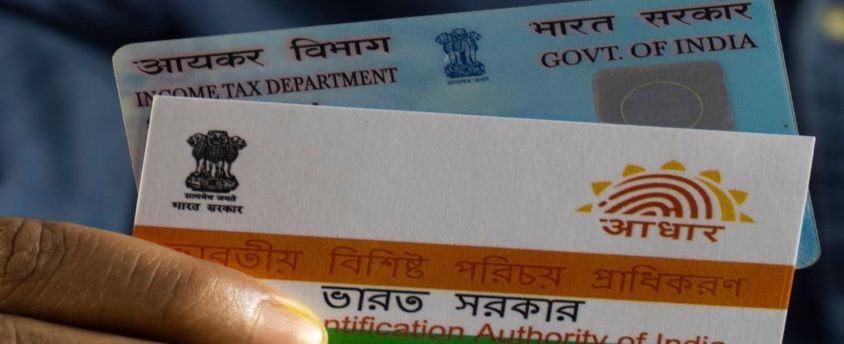
Why in News?
- The Finance Ministry has extended the last date to link Permanent Account Number (PAN) and Aadhaar by three months from March 31 to June 30, 2023.
What is the rationale behind linking PAN with Aadhaar?
- The Income-tax Department announced the linking of PAN with Aadhaar after it came across instances where multiple permanent account numbers (PANs) were allotted to one person, or where one PAN was allotted to more than one person.
- To have a robust way of de-duplication of the PAN database, it was made mandatory for a taxpayer who is eligible to obtain Aadhaar, to quote his Aadhaar in the application form for PAN and return of income.
Who needs to link PAN with Aadhaar?
- As per a circular issued by CBDT in March 2022, the Income-tax Act makes it mandatory for every person who has been allotted a PAN as on July 1, 2017, to intimate his/her Aadhaar number so that Aadhaar and PAN can be linked.
Who is not required to link PAN with Aadhaar?
- There are a few categories of individuals for whom this linkage is not compulsory.
- Any person of age 80 years and above;
- A non-resident as per the Income-tax Act;
- A person who is not a citizen of India.
What will happen if PAN is not linked with Aadhaar?
- CBDT has said that in case a person fails to link his or her PAN with Aadhaar, the PAN will become inoperative. In such a case, the person will not be able to furnish, intimate, or quote his/ her PAN, and shall be liable to all the consequences under the Income-tax Act for such failure. Some of the major implications of non-compliance are:
- The person shall not be able to file the income tax return using the inoperative PAN.
- Pending returns will not be processed.
- Pending refunds cannot be issued to inoperative PANs.
- Pending proceedings as in the case of defective returns cannot be completed once the PAN is inoperative.
- Tax will be required to be deducted at a higher rate if PAN becomes inoperative.
- Besides these consequences, the person may find difficulties in doing other financial transactions such as with banks, as PAN is an important KYC criterion for these transactions.
And why has SEBI made it mandatory for investors to link PAN with Aadhaar?
- Since PAN is the key identification number and part of KYC requirements for all transactions in the securities market, all SEBI-registered entities and Market Infrastructure Institutions (MIIs) are required to ensure valid KYC for all participants.
- All existing investors are required to ensure the linking of their PAN with their Aadhaar before June 30, 2023, for continual and smooth transactions in the securities market and to avoid consequences of non-compliance such accounts would be considered non-KYC compliant, and there could be restrictions on securities and other transactions until the PAN and Aadhaar are linked.
How to link PAN with Aadhaar?
- One can link PAN and Aadhaar by clicking on the Link Aadhaar option available on the official website of the Income-tax Department, www.incometax.gov.in.
Edappadi Palaniswami declared AIADMK general secretary
29, Mar 2023
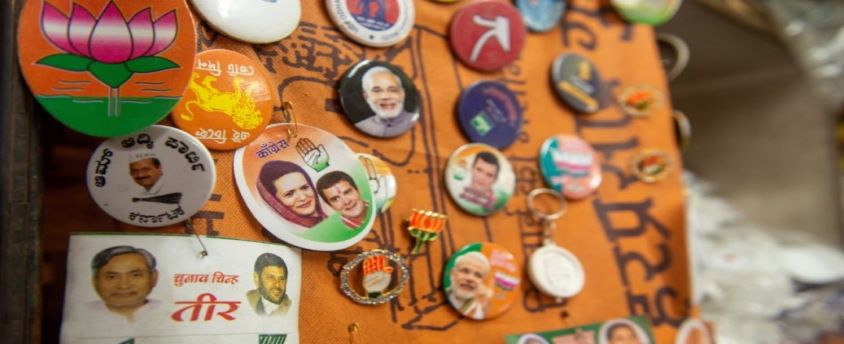
Why in News?
- Moments after the Madras High Court dismissed interim applications filed by former AIADMK coordinator O. Panneerselvam and a few of his colleagues against resolutions of the July 11, 2022 party general council and the consequent general secretary election, Leader of Opposition in the Assembly, Edappadi K. Palaniswami, was declared elected as the party’s general secretary.
Firstly, how are symbols allotted to political parties?
- As per the guidelines, to get a symbol allotted:
- A party/candidate has to provide a list of three symbols from the EC’s free symbols list at the time of filing nomination papers.
- Among them, one symbol is allotted to the party/candidate on a first-come-first-serve basis.
- When a recognised political party splits, the Election Commission takes the decision on assigning the symbol.
Powers of Election Commission:
- The Election Symbols (Reservation and Allotment) Order, 1968 empowers the EC to recognise political parties and allot symbols.
- Under Paragraph 15 of the Order, it can decide disputes among rival groups or sections of a recognised political party staking claim to its name and symbol.
- The EC is also the only authority to decide issues on a dispute or a merger. The Supreme Court upheld its validity in Sadiq Ali and another vs. ECI in 1971.
How many types of symbols are there?
- As per the Election Symbols (Reservation and Allotment) (Amendment) Order, 2017, party symbols are either:
- Reserved: Eight national parties and 64 state parties across the country have “reserved” symbols.
- Free: The Election Commission also has a pool of nearly 200 “free” symbols that are allotted to the thousands of unrecognised regional parties that pop up before elections.
What are the Election Commission’s powers in a dispute over the election symbol when a party splits?
- On the question of a split in a political party outside the legislature, Para 15 of the Symbols Order, 1968, states:
- “When the Commission is satisfied that there are rival sections or groups of a recognised political party each of whom claims to be that party the Commission may decide that one such rival section or group or none of such rival sections or groups is that recognised political party and the decision of the Commission shall be binding on all such rival sections or groups.”
- This applies to disputes in recognised national and state parties (like the LJP, in this case). For splits in registered but unrecognised parties, the EC usually advises the warring factions to resolve their differences internally or to approach the court.
- Please note that before 1968, the EC issued notifications and executive orders under the Conduct of Election Rules, 1961.
Disqualification of MPs
25, Mar 2023
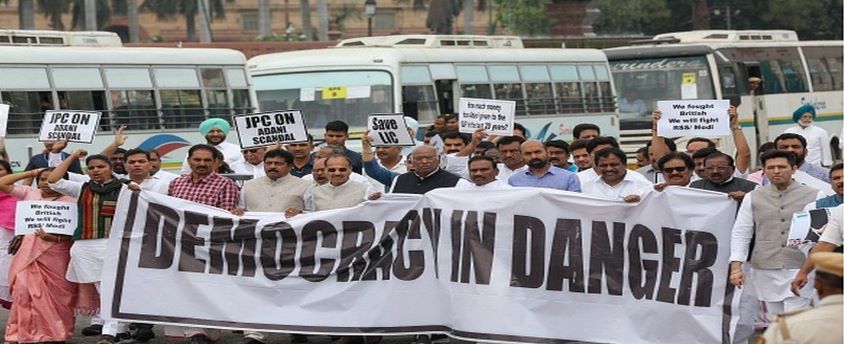
Why in News?
- Congress leader Rahul Gandhi has been disqualified from the Lok Sabha, a day after he was convicted in a defamation case by a Surat court.
Constitutional Provisions for Disqualification of MLAs:
- Under the Constitution, a person shall be disqualified for being chosen as and for being a member of the legislative assembly or legislative council of a state:
- If he holds any office of profit under the Union or state government (except that of a minister or any other office exempted by state legislature),
- If he is of unsound mind and stands so declared by a court,
- If he is an undischarged insolvent,
- If he is not a citizen of India or has voluntarily acquired the citizenship of a foreign state or is under any acknowledgement of allegiance to a foreign state, and
- If he is so disqualified under any law made by Parliament.
Parliamentary Provisions for Disqualification of MLAs:
The Parliament has prescribed a number of additional disqualifications in the Representation of People Act (1951) and the same is followed by Legislative Assembly and Council:
- He must not have been found guilty of certain election offences or corrupt practices in the elections.
- He must not have been convicted for any offence resulting in imprisonment for two or more years.
- But, the detention of a person under a preventive detention law is not a disqualification.
- He must not have failed to lodge an account of his election expenses within the time.
- He must not have any interest in government contracts, works or services.
- He must not be a director or managing agent nor hold an office of profit in a corporation in which the government has at least 25 per cent share.
- He must not have been dismissed from government service for corruption or disloyalty to the state.He must not have been convicted for promoting enmity between different groups or for the offence of bribery.He must not have been punished for preaching and practicing social crimes such as untouchability, dowry and sati.
- The governor’s decision is final on the question whether a member has become subject to any of the above disqualifications.
- The governor should obtain the opinion of the Election Commission and act accordingly.
Disqualification on Ground of Defection:
- The Constitution lays down that a person shall be disqualified for being a member of either House of state legislature if he is so disqualified on the ground of defection under the provisions of the Tenth Schedule.
- The question of disqualification under the Tenth Schedule is decided by the Chairman, in the case of legislative council and, Speaker, in the case of legislative assembly.
- In 1992, the Supreme Court ruled that the decision of Chairman/Speaker in this regard is subject to judicial review.
Government bats for simultaneous polls
18, Mar 2023

Why in News?
- The government has recently batted for holding simultaneous elections to Lok Sabha and State assemblies, saying it would result in huge saving to the public exchequer, as it listed out “imperatives” such as amending the Constitution and bringing all political parties on board before carrying out the gigantic exercise.
Background:
- While the Centre may not be planning to amend the Representation of the People Act, it has held meetings with various stakeholders, including the EC, on the possibility of States adopting the same electoral roll for local body polls. Prime Minister Narendra Modi has spoken in favour of “One Nation, One Election one nation, one election” many times.
What is One Nation, One Election?
- It refers to holding elections to Lok Sabha, State Legislative Assemblies, Panchayats and Urban local bodies simultaneously, once in five years.
But, what are the challenges posed by frequent elections?
- Massive expenditure.
- Policy paralysis that results from the imposition of the Model Code of Conduct during election time.
- Impact on delivery of essential services.
- Burden on crucial manpower that is deployed during election time.
- Puts pressure on political parties, especially smaller ones, as elections are becoming increasingly expensive.
Benefits of Simultaneous Elections:
- Governance and consistency: The ruling parties will be able to focus on legislation and governance rather than having to be in campaign mode forever.
- Reduced Expenditure of Money and Administration.
- Continuity in policies and programmes.
- Efficiency of Governance: Populist measures by governments will reduce.
- The impact of black money on the voters will be reduced as all elections are held at a time.
Impact on Regional parties:
- There is always a tendency for voters to vote the same party in power in the state and at the Centre in case the Lok Sabha polls and the state elections are held together.
- For simultaneous elections to be implemented, Changes to be made in Constitution and Legislations:
- Article 83 which deals with the duration of Houses of Parliament need an amendment.
- Article 85 (on dissolution of Lok Sabha by the president).
- Article 172 (relating to the duration of state legislatures).
- The Representation of People Act, 1951 Act would have to be amended to build in provisions for stability of tenure for both parliament and assemblies. This should include the following crucial elements:
- Restructuring the powers and functions of the ECI to facilitate procedures required for simultaneous elections
- A definition of simultaneous election can be added to section 2 of the 1951 act.
What is the Common Electoral Roll?
- Under the Common Electoral Roll, only one voter list will be used for Lok Sabha, Vidhan Sabha and other elections.
How many types of electoral rolls do we have in our country and why the distinction?
- In many states, the voters’ list for the panchayat and municipality elections is different from the one used for Parliament and Assembly elections.
- The distinction stems from the fact that the supervision and conduct of elections in our country are with two constitutional authorities — the Election Commission (EC) of India and the State Election Commissions (SECs).
Significance:
- The preparation of a separate voters list causes duplication of the effort and the expenditure.
- Therefore, a common electoral roll and simultaneous elections as a way to save an enormous amount of effort and expenditure.
Electoral Bonds Scheme
08, Mar 2023
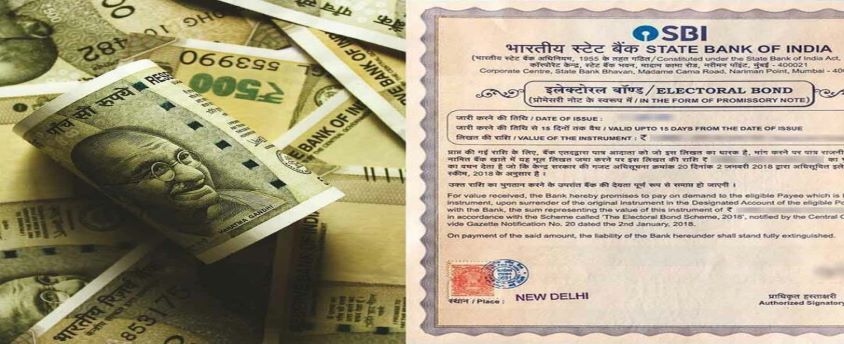
Why in News?
- Five years ago, the sale window for the first tranche of Electoral Bonds was opened in March 2018.
What is an Electoral Bond?
- Electoral Bond is a financial instrument for making donations to political parties.
- The bonds are issued in multiples of Rs. 1,000, Rs. 10,000, Rs. 1 lakh, Rs. 10 lakh and Rs. 1 crore without any maximum limit.
- State Bank of India is authorised to issue and encash these bonds, which are valid for fifteen days from the date of issuance.
- These bonds are redeemable in the designated account of a registered political party.
- Every party that is registered under section 29A of the Representation of the Peoples Act, 1951 and has secured at least 1% of the votes polled in the most recent Lok Sabha or State election will be allotted a verified account by the Election Commission of India.
- Electoral bond transactions can be made only via this account.
- The bonds are available for purchase by any person (who is a citizen of India or incorporated or established in India) for a period of ten days each in the months of January, April, July and October as may be specified by the Central Government.
- A person being an individual can buy bonds, either singly or jointly with other individuals.
- Donor’s name is not mentioned on the bond.
- During general elections, the central government may specify an additional period of thirty days for sale of these bonds.
- There have been some occasions when the government has deviated from the specified periodicity for issuance of these bonds.
- For example, the sixth tranche of electoral bonds was issued from 1st-10th November 2018 and electoral bonds were sold in the months of March, April and May during 2019 general elections.
What are the concerns?
- While the Scheme acts as a check against traditional under-the-table donations as it insists on cheque and digital paper trails of transactions, several key provisions of the scheme make it highly controversial.
- Anonymity:
- Neither the donor (who could be an individual or a corporate) nor the political party is obligated to reveal whom the donation comes from.
- In 2019, the Supreme Court held that all political parties who had received donations through electoral bonds must submit details to the Election Commission of India.
- This undercuts a fundamental constitutional principle, the freedom of political information, which is an integral element of Article 19(1) (a) of the Constitution.
- Defeating Transparency:
- It defeats the fundamental principle of transparency in political finance because it conceals from public scrutiny the identity of the corporates and moneybags.
- Asymmetric Opacity:
- The government is always in a position to know who the donor is because the bonds are purchased through the SBI.
- This asymmetry of information threatens to colour the process in favour of whichever political party is ruling at the time.
- Chanel of Black money:
- Elimination of a cap of 7.5% on corporate donations, elimination of requirement to reveal political contributions in profit and loss statements and also the elimination of the provision that a corporation must be three years in existence, undercuts the intent of the scheme.
- Any troubled, dying or shell companies can donate an unlimited amount anonymously to a political party giving them a convenient channel for business to round-trip their cash parked in tax havens for a favour or advantage granted in return for something.
Way Forward:
- There is a need for fixing the governance system and effective regulation of political financing along with bold reforms to break the vicious cycle of corruption and erosion of quality of democratic polity. It is crucial to plug the loopholes in the current laws to make the entire governance machinery more accountable and transparent.
- Voters can help bring in substantial changes by demanding awareness campaigns. If voters reject candidates and parties that overspend or bribe them, democracy would move a step higher.
Anti-Defection Law
25, Feb 2023
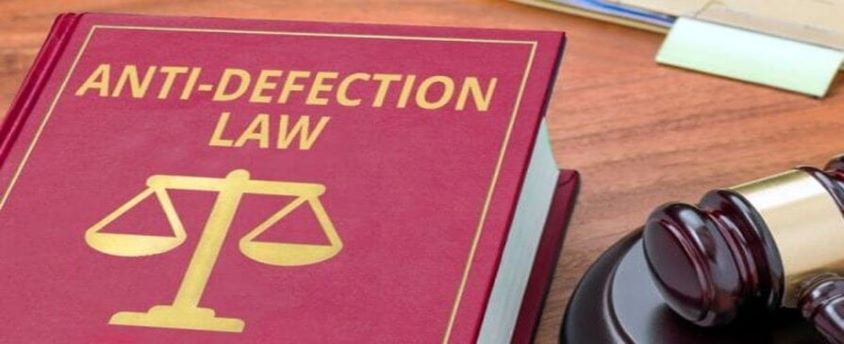
Why in News?
- The Supreme Court’s examining of the ‘Maharashtra political controversy cases’ could either end up as a counterweight to political games or make government destabilising even easier.
What’s the issue?
- The practice of politicians deserting parties just ahead of elections is not unusual. And every time there are defections, the anti-defection law special damages san diego, which penalises individual lawmakers for switching parties, comes into the picture.About Anti-Defection Law:
- The Tenth Schedule of Indian Constitution is popularly known as the Anti-Defection Act.
- Original constitution had no such provisions. It was included in the Constitution in 1985 by the Rajiv Gandhi government.
- The main intent of the law was to deter “the evil of political defections” by legislators motivated by the lure of office or other similar considerations.
- The grounds for disqualification under the Anti-Defection Law includes
- If an elected member voluntarily gives up his membership of a political party.
- If he votes or abstains from voting in such House contrary to any direction issued by his political party or anyone authorized to do so, without obtaining prior permission.
- Going against the party whip.
- As a pre-condition for his disqualification, his abstention from voting should not be condoned by his party or the authorized person within 15 days of such incident.
- Articles 102 (2) and 191 (2) deals with anti-defection.
- The law disallows MPs/ MLAs to switch parties after elections, make the members follow the whips issued by their party.
- It also applies to a nominated member if he/ she join a political party after 6 months of nomination and to an independent candidate if he/she joins a party after the election.,
What is not a Defection?
- A split in a political party won’t be considered a defection if a complete political party merges with another political party.
- If a new political party is created by the elected members of one party
- If he or she or alternative members of the party haven’t accepted the merger between the two parties and opted to perform as a separate group from the time of such a merger.When does the 10th schedule might not apply?
- The 10th Schedule of the Indian Constitution commonly referred to as the Anti-defection Act says that disqualification on ground of defection will not apply in case of a split.
- Where a member of a House claims that he/she and any other members of his/her legislature party constitute the group representing a faction which has arisen as a result of a split in the original political party and such group consists of not less than two-thirds of the members of such legislature party, he/she shall not be disqualified.
- From the time of such split, the faction shall be deemed to be the political party to which he/she henceforth belongs.
What are the loop-holes?
- Resignation as MLA was not one of the conditions.
- Exploiting this loophole, the 17 rebel MLAs in Karnataka resigned, their act aimed at ending the majority of the ruling coalition and, at the same time, avoiding disqualification.
- However, the Speaker refused to accept the resignations and declared them disqualified. This was possible as the legislation empowers the presiding officer of the House (i.e. the Speaker) to decide on complaints of defection under no time constraint.
- The law originally protected the Speaker’s decision from judicial review.
- However, this safeguard was struck down in Kihoto Hollohan v. Zachillhu
and Others (1992). - While the SC upheld the Speaker’s discretionary power, it underscored that the Speaker functioned as a tribunal under the anti-defection law, thereby making her/his decisions subject to judicial review.
- This judgment enabled judiciary to become the watchdog of the anti-defection law, instead of the Speaker, who increasingly had become a political character contrary to the expected neutral constitutional role.
- The same could be witnessed in Shrimanth Balasaheb Patel & Ors vs. Speaker Karnataka Legislative Assembly & Ors (2019), where the three-judge SC bench upheld the then Karnataka Speaker’s decision of disqualification of the 17 rebel MLAs.
- However, it struck down his ban on the MLAs from contesting elections till 2023, negating the only possible permanent solution to the problem.
- The Supreme Court played the role of a neutral umpire in this political slugfest.
- But, the spectacle of MLAs hoarded in a bus, and being sent to a resort, openly exposed not just the absence of ideological ties between a leader and his party, but also her/his weak moral character.
- It was also upsetting to see public acceptance of such malpractices as part of politics, with some even calling it Chanakya niti!
Is there any safeguard for anti-defection?
- The Anti-Defection Law provided a safeguard for defections made on genuine ideological differences.
- It accepted “split” within a party if at least one-third of the members of the legislative party defect, and allowed the formation of a new party or “merger” with other political party if not less than two-thirds of the party’s members commit to it.
- The 91st Constitutional Amendment introduced in 2003 deleted the provision allowing split.
- The 91st Amendment also barred the appointment of defectors as Ministers until their disqualification period is over or they are re-elected, whichever is earlier.
- But, obviously, such laws have not put to rest the trend of defections.
What should be done?
- The main issue, as witnessed in Karnataka, is that the defectors treat disqualification as a mere detour, before they return to the House or government by re-contesting.
- This can only be stopped by extending the disqualification period from re-contesting and appointment to Chairmanships/Ministries to at least six years.
- The minimum period limit of six years is needed to ensure that the defectors are not allowed to enter the election fray for least one election cycle, which is five years.
- Of course, MLAs can still be bought from the ruling dispensation to bring it to a minority by being paid hefty sums, simply to stay at home for six years.
Contradictory Reforms to the Law:
- Nowadays, no real democratic discussions happen inside political parties about major issues affecting the country. Individual MPs and MLAs need to be empowered to think independently.
- Anti-defection law should be applied only to confidence and no-confidence motions (Dinesh Goswami Committee on electoral reforms, 1990) or only when the government is in danger (Law Commission (170th report, 1999).
- The rationale that a representative is elected on the basis of the party’s programme can be extended to pre-poll alliances.
- Instead of making Speaker the authority for disqualification, the decision should be made by the president or the governor on the advice of the Election Commission. This would make the process similar to the disqualification procedure as given in Representation of Peoples Act (RPA).
- There can be additional penalties for defectors as well.
SC urgently lists Uddhav Thackeray’s plea to stay EC order on Shiv Sena
22, Feb 2023

Why in News?
- The Supreme Court has recently listed former Maharashtra Chief Minister Uddhav Thackeray’s petition challenging the decision of the Election Commission of India (ECI) to allot party name ‘Shiv Sena’ and symbol ‘bow and arrow’ to the Eknath Shinde faction for hearing tomorrow.
Firstly, how are symbols allotted to political parties?
- As per the guidelines, to get a symbol allotted:
- A party/candidate has to provide a list of three symbols from the EC’s free symbols list at the time of filing nomination papers.
- Among them, one symbol is allotted to the party/candidate on a first-come-first-serve basis.
- When a recognised political party splits, the Election Commission takes the decision on assigning the symbol.
Powers of Election Commission:
- The Election Symbols (Reservation and Allotment) Order, 1968 empowers the EC to recognise political parties and allot symbols.
- Under Paragraph 15 of the Order, it can decide disputes among rival groups or sections of a recognised political party staking claim to its name and symbol.
- The EC is also the only authority to decide issues on a dispute or a merger. The Supreme Court upheld its validity in Sadiq Ali and another vs. ECI in 1971.
How many types of symbols are there?
- As per the Election Symbols (Reservation and Allotment) (Amendment) Order, 2017, party symbols are either:
- Reserved: Eight national parties and 64 state parties across the country have “reserved” symbols.
- Free: The Election Commission also has a pool of nearly 200 “free” symbols that are allotted to the thousands of unrecognised regional parties that pop up before elections.
What are the Election Commission’s powers in a dispute over the election symbol when a party splits?
- On the question of a split in a political party outside the legislature, Para 15 of the Symbols Order, 1968, states: “When the Commission is satisfied that there are rival sections or groups of a recognised political party each of whom claims to be that party the Commission may decide that one such rival section or group or none of such rival sections or groups is that recognised political party and the decision of the Commission shall be binding on all such rival sections or groups.”
- This applies to disputes in recognised national and state parties (like the LJP, in this case). For splits in registered but unrecognised parties, the EC usually advises the warring factions to resolve their differences internally or to approach the court.
- Please note that before 1968, the EC issued notifications and executive orders under the Conduct of Election Rules, 1961.
Vacancy on Deputy Speaker
16, Feb 2023
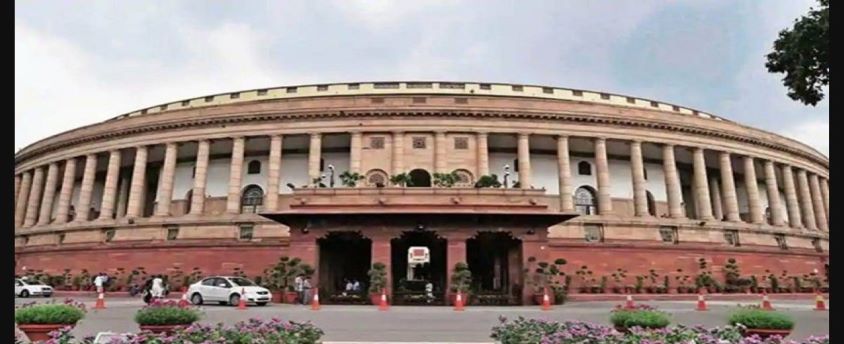
Why in News?
- The Supreme Court has issued notices on a petition highlighting the vacant posts of Deputy Speakers in Lok Sabha and five state assemblies for years.
About the News:
- A Bench sought responses on a PIL that contends that not electing a Deputy Speaker to the 17th (present) Lok Sabha, is “against the letter and spirit of the Constitution”.
Constitutional provisions regarding Deputy Speaker:
- Article 93 of the Constitution of India establishes the post of the Deputy Speaker of Lok Sabha and Articles 94-96 detail their appointment, removal, and powers.
- In the absence of the Speaker, the Deputy Speaker serves as the Speaker and wields the full powers of the Speaker.
- Deputy Speaker is not subordinate to the Speaker and is directly responsible to the House.
- Article 178 of the Constitution establishes the post of Deputy Speaker of assemblies and Articles 179-181 deal with their powers and appointment or resignation.
Is it mandatory to have a Deputy Speaker?
- Constitutional experts point out that both Articles 93 and 178 use the word “shall”, indicating that the election of Speaker and Deputy Speaker is mandatory under the Constitution.
Do the powers of the Speaker extend to the Deputy Speaker as well?
- Article 95(1) says: “While the office of Speaker is vacant, the duties of the office shall be performed by the Deputy Speaker”.
- The Deputy Speaker has the same powers as the Speaker when presiding over a sitting of the House. All references to the Speaker in the Rules are deemed to be references to the Deputy Speaker when he presides.
What is the position of the Union government on the current vacancy in the post of Deputy Speaker?
- The Treasury benches have maintained there is no “immediate requirement” for a Deputy Speaker as “bills are being passed and discussions are being held” as normal in the House. A Minister argued that “there is a panel of nine members — senior, experienced and selected from different parties — who can act as chairpersons to assist the Speaker to run the House”.
Can the courts intervene in cases of a delay in electing the Deputy Speaker?
- Article 122(1) says: “The validity of any proceedings in Parliament shall not be called in question on the ground of any alleged irregularity of procedure.”
- However, experts said that the courts do have jurisdiction to at least inquire into why there has been no election to the post of Deputy Speaker since the Constitution does envisage an election “as soon as may be”.
Validity of Electoral Bonds Scheme
31, Jan 2023
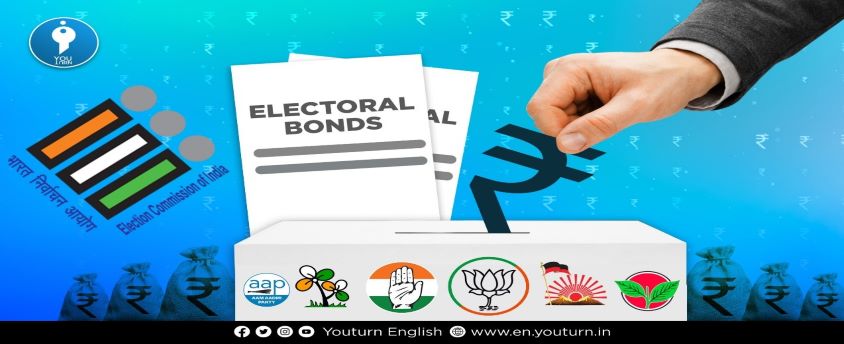
Why in News?
- The Supreme Court is on January 31 scheduled to examine whether petitions challenging the validity of electoral bonds scheme need to be referred to a Constitution Bench.
What is an Electoral Bond?
- Electoral Bond is a financial instrument for making donations to political parties.
- The bonds are issued in multiples of Rs. 1,000, Rs. 10,000, Rs. 1 lakh, Rs. 10 lakh and Rs. 1 crore without any maximum limit.
- State Bank of India is authorised to issue and encash these bonds, which are valid for fifteen days from the date of issuance.
- These bonds are redeemable in the designated account of a registered political party.
- Every party that is registered under section 29A of the Representation of the Peoples Act, 1951 and has secured at least 1% of the votes polled in the most recent Lok Sabha or State election will be allotted a verified account by the Election Commission of India.
- Electoral bond transactions can be made only via this account.
- The bonds are available for purchase by any person (who is a citizen of India or incorporated or established in India) for a period of ten days each in the months of January, April, July and October as may be specified by the Central Government.
- A person being an individual can buy bonds, either singly or jointly with other individuals.
- Donor’s name is not mentioned on the bond.
- During general elections, the central government may specify an additional period of thirty days for sale of these bonds. There have been some occasions when the government has deviated from the specified periodicity for issuance of these bonds.
- For example, the sixth tranche of electoral bonds was issued from 1st-10th November 2018 and electoral bonds were sold in the months of March, April and May during 2019 general elections.
What are the concerns?
- While the Scheme acts as a check against traditional under-the-table donations as it insists on cheque and digital paper trails of transactions, several key provisions of the scheme make it highly controversial.
- Anonymity:
- Neither the donor (who could be an individual or a corporate) nor the political party is obligated to reveal whom the donation comes from.
- In 2019, the Supreme Court held that all political parties who had received donations through electoral bonds must submit details to the Election Commission of India.
- This undercuts a fundamental constitutional principle, the freedom of political information, which is an integral element of Article 19(1) (a) of the Constitution.
- Defeating Transparency:
- It defeats the fundamental principle of transparency in political finance because it conceals from public scrutiny the identity of the corporates and moneybags.
- Asymmetric Opacity:
- The government is always in a position to know who the donor is because the bonds are purchased through the SBI.
- This asymmetry of information threatens to colour the process in favour of whichever political party is ruling at the time.
- Chanel of Black money:
- Elimination of a cap of 7.5% on corporate donations, elimination of requirement to reveal political contributions in profit and loss statements and also the elimination of the provision that a corporation must be three years in existence, undercuts the intent of the scheme.
- Any troubled, dying or shell companies can donate an unlimited amount anonymously to a political party giving them a convenient channel for business to round-trip their cash parked in tax havens for a favour or advantage granted in return for something.
Way Forward:
- There is a need for fixing the governance system and effective regulation of political financing along with bold reforms to break the vicious cycle of corruption and erosion of quality of democratic polity. It is crucial to plug the loopholes in the current laws to make the entire governance machinery more accountable and transparent.
- Voters can help bring in substantial changes by demanding awareness campaigns. If voters reject candidates and parties that overspend or bribe them, democracy would move a step higher.
Disqualification of MPs
27, Jan 2023

Why in News?
- The Kerala High Court recently suspended the conviction and sentence of 10 years of rigorous imprisonment awarded by the Kavarathi Sessions Court to disqualified Lakshadweep MP Mohammed Faizal in a case of attempt to murder Mohammed Salih, son-in-law of former Union Minister P.M. Sayeed, during the 2009 Lok sabha polls.
Constitutional Provisions for Disqualification of MLAs:
- Under the Constitution, a person shall be disqualified for being chosen as and for being a member of the legislative assembly or legislative council of a state:
- If he holds any office of profit under the Union or state government (except that of a minister or any other office exempted by state legislature),
- If he is of unsound mind and stands so declared by a court,
- If he is an undischarged insolvent,
- If he is not a citizen of India or has voluntarily acquired the citizenship of a foreign state or is under any acknowledgement of allegiance to a foreign state, and
- If he is so disqualified under any law made by Parliament.
Parliamentary Provisions for Disqualification of MLAs:
The Parliament has prescribed a number of additional disqualifications in the Representation of People Act (1951) and the same is followed by Legislative Assembly and Council:
- He must not have been found guilty of certain election offences or corrupt practices in the elections.
- He must not have been convicted for any offence resulting in imprisonment for two or more years.
- But, the detention of a person under a preventive detention law is not a disqualification.
- He must not have failed to lodge an account of his election expenses within the time.
- He must not have any interest in government contracts, works or services.
- He must not be a director or managing agent nor hold an office of profit in a corporation in which the government has at least 25 per cent share.
- He must not have been dismissed from government service for corruption or disloyalty to the state.
- He must not have been convicted for promoting enmity between different groups or for the offence of bribery.
- He must not have been punished for preaching and practicing social crimes such as untouchability, dowry and sati.
- The governor’s decision is final on the question whether a member has become subject to any of the above disqualifications.
- The governor should obtain the opinion of the Election Commission and act accordingly.
Disqualification on Ground of Defection:
- The Constitution lays down that a person shall be disqualified for being a member of either House of state legislature if he is so disqualified on the ground of defection under the provisions of the Tenth Schedule.
- The question of disqualification under the Tenth Schedule is decided by the Chairman, in the case of legislative council and, Speaker, in the case of legislative assembly.
- In 1992, the Supreme Court ruled that the decision of Chairman/Speaker in this regard is subject to judicial review.
Whip in Parliament
05, Jan 2023
Why in News?
- In a recent Constitution Bench judgment, the Supreme Court held that a country with a multi-party system cannot afford to crack the whip every time a Minister makes an offensive or disparaging statement.
What is Whip?
- A whip is an official of a political party who acts as the party’s ‘enforcer’ inside the legislative assembly or house of parliament.
- In India, every major political party appoints a whip who is responsible for the party’s discipline and behaviour on the floor of the House.
- A whip is an important office-bearer of the party in the Parliament.
- Parties appoint a senior member from among their House contingents to issue whips — this member is called a Chief Whip, and he/she is assisted by additional Whips.
- India inherited the concept of the whip from the British parliamentary system.
Violation of Whip:
- A legislator may face disqualification proceedings if she/he disobeys the whip of the party unless the number of lawmakers defying the whip is 2/3rds of the party’s strength in the house.
- Disqualification is decided by the Speaker of the house.
Limitations of Whip:
- There are some cases such as Presidential elections where whips cannot direct a Member of Parliament (MP) or Member of Legislative Assembly (MLA) to vote in a particular fashion.
Types of Whips:
- The One-line whip to inform the members about a vote. It allows a member to abstain in case they decide not to follow the party line.
- The Two-line whip is issued to direct the members to be present in the House at the time of voting. No special instructions are given on the pattern of voting.
- The Three-line whip is issued to members directing them to vote as per the party line. It is the strictest of all the whip.
What are the Functions of Whip?
- The whip plays a crucial role in ensuring the smooth and efficient conduct of business on the floor of the House.
- He is charged with the responsibility of ensuring the attendance of his party members in large numbers and securing their support in favour of or against a particular issue.
- He ensures discipline among party members in the House.
- He identifies the signs of discontent among MPs and informs the respective leaders of their party.
- He or she acts as a binding force in the party and responsible for maintaining the internal party organisation in the Parliament.
- Under the Tenth Schedule (anti-defection law) a political party has a constitutional right to issue a whip to its legislators.
Delimitation Commission
04, Jan 2023

Why in News?
- The Assam state Cabinet recently approved the merger of four districts with their constituent districts.
About the News:
- Recently, the EC announced the process of delimitation of Assembly and Parliamentary constituencies in Assam, saying it would be based on Census data from 2001. Assam currently has 14 Lok Sabha constituencies and 126 Assembly constituencies.
What is Delimitation?
- Delimitation literally means the process of fixing limits or boundaries of territorial constituencies in a state that has a legislative body.
- Bifurcation of J&K into two UTs has led to redrawing of Assembly constituency boundaries. While, the UT of Ladakh will not have its own legislature, J&K will. This would be similar to Puducherry or Delhi.
- Such delimitation was also necessitated in 2014 when Andhra Pradesh and Telangana were bifurcated.
- According to the Delimitation Commission Act, 2002, the Delimitation Commission appointed by the Centre has to have three members: a serving or retired judge of the Supreme Court as the chairperson, and the Chief Election Commissioner or Election Commissioner nominated by the CEC and the State Election Commissioner as ex-officio members.
How Delimitation process is done?
- Under Article 82, the Parliament enacts a Delimitation Act after every Census.
- Under Article 170, States also get divided into territorial constituencies as per Delimitation Act after every Census.
- Once the Act is in force, the Union government sets up a Delimitation Commission.
- The new state assembly shall have 114 seats (currently 107), out of which only 90 will be open for elections, and the remaining 24 will be shadow seats reserved for the areas of the erstwhile state that have been occupied by Pakistan (PoJK).
- For the delimitation exercise, the population figures of 2011 census shall be taken as the basis.
- The J&K Representation of the People Act 1957 has now been invalidated and, instead, delimitation will be done as per the Representation of the People Act, 1950 (as amended from time to time) and provisions of Sections 59, 60 of Act 34 of 2019.
Who carry out the exercise?
- Delimitation is undertaken by a highly powerful commission. They are formally known as Delimitation Commission or Boundary Commission.
- These bodies are so powerful that its orders have the force of law and they cannot be challenged before any court.
- Such commissions have been constituted at least four times in India — in 1952 under the Delimitation Commission Act, 1952; in 1963 under Delimitation Commission Act, 1962; in 1973 under Delimitation Act, 1972 and last in 2002 under Delimitation Act, 2002.
- The commissions’ orders are enforced as per the date specified by the President of India. Copies of these orders are laid before the Lok Sabha or the concerned Legislative Assembly. No modifications are permitted.
Why delimitation is needed?
- To provide equal representation to equal segments of a population.
- Fair division of geographical areas so that one political party doesn’t have an advantage over others in an election.
- To follow the principle of “One Vote One Value”
What are the problems with Delimitation?
- States that take little interest in population control could end up with a greater number of seats in Parliament. The southern states that promoted family planning faced the possibility of having their seats reduced.
- In 2008, Delimitation was done based on the 2001 census, but the total number of seats in the Assemblies and Parliament decided as per the 1971 Census that was not changed.
- The constitution has also capped the number of Lok Shaba & Rajya Sabha seats to a maximum of 550 & 250 respectively and increasing populations are being represented by a single representative.
Aadhar Voter-ID linking
16, Dec 2022

Why in News?
- Law Minister Kiren Rijiju has recently informed the Parliament that over 54 crore voters out of a total of nearly 95 crore have opted to link their Aadhaar details with the electoral rolls.
Need for linking of Aadhaar and Voter ID:
- This has been a demand of the Election Commission ever since 2015.
- The EC had launched the National Electoral Law Purification and Authentication Programme to link the Aadhaar number with the voter ID number.
- It said the linking will weed out multiple enrolments in the name of one person.
- At that time, the programme was stalled as the Supreme Court ordered that the use of Aadhaar will remain optional to avail of welfare schemes.
- Following this, the EC modified its proposal and said the linking will be optional.
Other provisions in the Bill:
- It will provide registration of new voters on four qualifying dates in place of the existing January 1 of every year.
- At present, anyone turning 18 on or before January 1 will be eligible to be registered as a voter. Anyone born after January 1 will have to get enlisted only after a year.
- According to the bill, along with January 1, there will be three other qualifying dates – April 1, July 1 and October 1 – in every calendar year.
- The amendments also allow the elections to become gender neutral for service voters.
- The amendment will help replace the word ‘wife’ with the word ‘spouse’ making the statutes “gender neutral”.
- At present, an Armyman’s wife is entitled to be enrolled as a service voter, but a woman officer’s husband is not. With ‘wife’ being replaced by the term ‘spouse’, this will change.
What Are the Issues Raised Over Voter ID-Aadhaar Seeding?
- The proposal fails to specify the extent of data sharing between the ECI and UIDAI databases, the methods through which consent will be obtained, and whether consent to link the databases can be revoked.
- In the absence of a robust personal data protection law — a Bill in that regard is yet to clear Parliament — any move to allow sharing of data can prove to be problematic. There would be an intrusion to the privacy of the individual.
Constitutional validity of J&K Reorganisation Act
02, Dec 2022
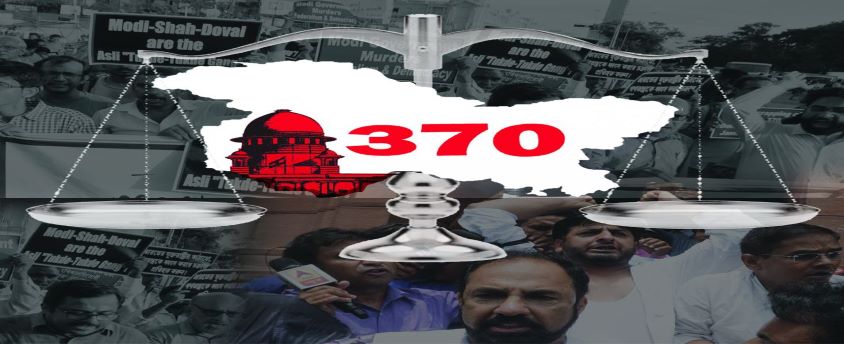
Why in News?
- The Supreme Court questioned petitioners on why they did not challenge the constitutionality of a specific provision in the J&K Reorganisation Act, 2019.
About the J&K Delimitation:
- The commission came into being by virtue of an Act of the Parliament, under the provisions of Part V of the Jammu and Kashmir Reorganisation Act, 2019. It is redrawing boundaries of seven additional seats for the 83-member Assembly.
- “In exercise of powers conferred by Section 3 of the Delimitation Act 2002 (33 of 2002), the Central government hereby makes the further amendment of two months in the notification of Government of India in the Ministry of Law and Justice (Legislative department no So-1015(e) dated 6th March 2020.
- In the notification in paragraph two for the words ‘two years’ the words ‘two years and two months’ shall be substituted,” read the gazette notification.
- Originally set up in March 2020, the commission was given a one-year extension as its work got delayed after the National Conference (NC) had refused to participate in the deliberations.
- The NC decided to take part in the commission proceedings only after Prime Minister Narendra Modi held an all-party meeting in June 2021.
What is Delimitation?
- Delimitation literally means the process of fixing limits or boundaries of territorial constituencies in a state that has a legislative body.
- Bifurcation of J&K into two UTs has led to redrawing of Assembly constituency boundaries. While, the UT of Ladakh will not have its own legislature, J&K will. This would be similar to Puducherry or Delhi.
- Such delimitation was also necessitated in 2014 when Andhra Pradesh and Telangana were bifurcated.
- According to the Delimitation Commission Act, 2002, the Delimitation Commission appointed by the Centre has to have three members: a serving or retired judge of the Supreme Court as the chairperson, and the Chief Election Commissioner or Election Commissioner nominated by the CEC and the State Election Commissioner as ex-officio members.
How Delimitation process is done?
- Under Article 82, the Parliament enacts a Delimitation Act after every Census.
- Under Article 170, States also get divided into territorial constituencies as per Delimitation Act after every Census.
- Once the Act is in force, the Union government sets up a Delimitation Commission.
- The new state assembly shall have 114 seats (currently 107), out of which only 90 will be open for elections, and the remaining 24 will be shadow seats reserved for the areas of the erstwhile state that have been occupied by Pakistan (PoJK).
- For the delimitation exercise, the population figures of 2011 census shall be taken as the basis.
- The J&K Representation of the People Act 1957 has now been invalidated and, instead, delimitation will be done as per the Representation of the People Act, 1950 (as amended from time to time) and provisions of Sections 59, 60 of Act 34 of 2019.
Who carry out the exercise?
- Delimitation is undertaken by a highly powerful commission. They are formally known as Delimitation Commission or Boundary Commission.
- These bodies are so powerful that its orders have the force of law and they cannot be challenged before any court.
- Such commissions have been constituted at least four times in India — in 1952 under the Delimitation Commission Act, 1952; in 1963 under Delimitation Commission Act, 1962; in 1973 under Delimitation Act, 1972 and last in 2002 under Delimitation Act, 2002.
- The commissions’ orders are enforced as per the date specified by the President of India. Copies of these orders are laid before the Lok Sabha or the concerned Legislative Assembly. No modifications are permitted.
Why delimitation is needed?
- To provide equal representation to equal segments of a population.
- Fair division of geographical areas so that one political party doesn’t have an advantage over others in an election.
- To follow the principle of “One Vote One Value.”
What are the problems with Delimitation?
- States that take little interest in population control could end up with a greater number of seats in Parliament. The southern states that promoted family planning faced the possibility of having their seats reduced.
- In 2008, Delimitation was done based on the 2001 census, but the total number of seats in the Assemblies and Parliament decided as per the 1971 Census that was not changed.
- The constitution has also capped the number of Lok Shaba & Rajya Sabha seats to a maximum of 550 & 250 respectively and increasing populations are being represented by a single representative.
Common Electoral Roll and Simultaneous Poll
09, Feb 2022
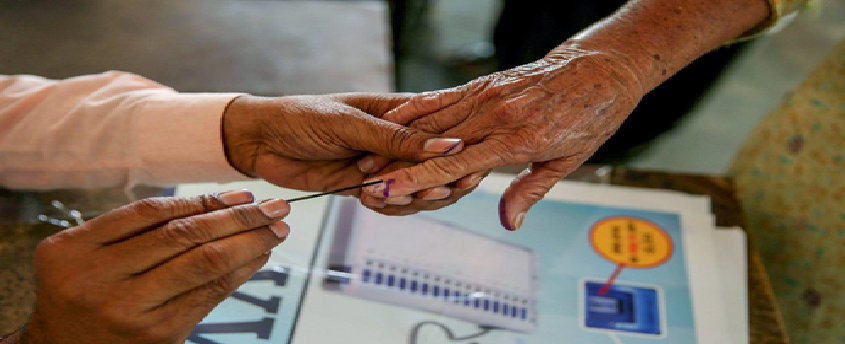
Why in News?
- The Centre has clarified that it is not planning on amending the Representation of the People Act, 1951 to enable a common electoral roll and simultaneous elections to all Electoral Bodies in the Country.
Background:
- While the Centre may not be planning to amend the Representation of the People Act, it has held meetings with various stakeholders, including the EC, on the possibility of States adopting the same electoral roll for local body polls. Prime Minister Narendra Modi has Spoken in favour of “One Nation, One Election one nation, one election” many times.
What is ‘?
- It refers to holding elections to Lok Sabha, State Legislative Assemblies, Panchayats and Urban local bodies simultaneously, once in five years.
But what are the Challenges Posed by Frequent Elections?
- Massive Expenditure.
- Policy paralysis that Results from the imposition of the Model Code of Conduct during election time.
- Impact on delivery of Essential Services.
- Burden on Crucial Manpower that is deployed during election time.
- Puts pressure on political Parties, Especially smaller ones, as elections are becoming Increasingly Expensive.
Benefits of Simultaneous Elections:
- Governance and consistency: The ruling parties will be able to focus on legislation and Governance rather than having to be in campaign mode forever.
- Reduced Expenditure of Money and Administration.
- Continuity in policies and programmes.
- Efficiency of Governance: Populist measures by governments will reduce.
- The Impact of Black Money on the voters will be reduced as all elections are held at a time.
Impact on Regional parties:
- There is always a tendency for voters to vote the same party in power in the state and at the Centre in case the Lok Sabha polls and the state elections are held together.
- For simultaneous elections to be implemented, Changes to be made in Constitution and Legislations:
- Article 83 which deals with the duration of Houses of Parliament need an amendment.
- Article 85 (on dissolution of Lok Sabha by the president).
- Article 172 (relating to the duration of state legislatures).
- The Representation of People Act, 1951 Act would have to be amended to build in provisions for stability of tenure for both parliament and assemblies. This should include the following crucial elements:
- Restructuring the powers and functions of the ECI to facilitate procedures required for simultaneous elections
- A definition of simultaneous election can be added to section 2 of the 1951 act.
What is the Common Electoral Roll?
- Under the Common Electoral Roll, only one voter list will be used for Lok Sabha, Vidhan Sabha and other elections.
How many Types of Electoral Rolls do we have in Our Country and why the Distinction?
- In many states, the voters’ list for the panchayat and municipality elections is different from the one used for Parliament and Assembly elections.
- The distinction stems from the fact that the supervision and conduct of elections in our country are with two constitutional authorities — the Election Commission (EC) of India and the State Election Commissions (SECs).
Significance:
- The preparation of a separate voters list causes duplication of the effort and the Expenditure.
- Therefore, a common electoral roll and Simultaneous elections as a way to save an Enormous Amount of Effort and Expenditure.
Panel Redraws All Five J&K LS Seats
07, Feb 2022
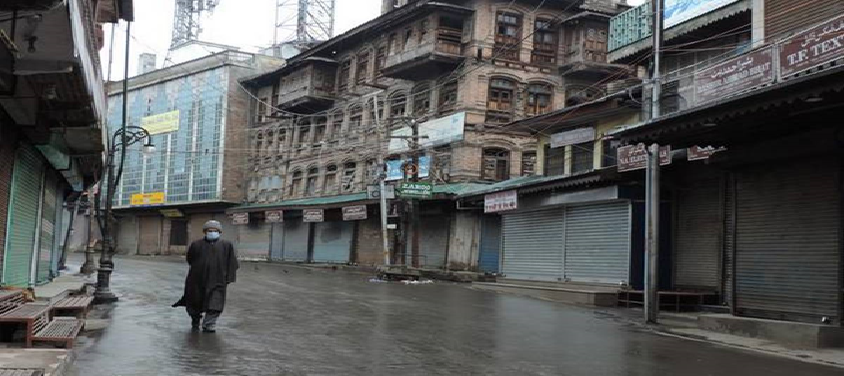
Why in News?
- The J&K Delimitation Commission has changed the complexion of most of the 90 Assembly seats, while reconfiguring and renaming 28 new Assembly constituencies and deleting 19 Assembly Segments in its Interim Report.
About the News:
- The interim report, shared with the associate members two days ago, suggested that the Kashmir division will get an additional seat in Kupwara, while the Jammu division will have one additional seat in Kathua district, one in Samba, one in Doda, one in Rajouri, one in Udhampur and one in Kishtwar.
- Of the six seats, three Assembly segments are from the Muslim-majority Chenab Valley and Pir Panjal valleys, while four are in the Hindu Jammu-Samba-Kathua belt.
- Seventeen constituencies have been redrawn in the Jammu province while 11 have been reconfigured in the Kashmir division. Similarly, nine names of Assembly constituencies in the Jammu division have vanished due to the reconfiguration and 10 names disappear from the Kashmir division.
- The Shri Mata Vaishno Devi constituency has been identified as the smallest of all with just 73,648 votes in the Jammu region.
- The Commission has also proposed reframing of Lok Sabha constituencies, with J&K earlier having five which included three seats from Kashmir and two from Jammu. It has suggested to distribute 18 Assembly segments among the five Lok Sabha constituencies.
- The newly carved Lok Sabha seat will havesix of the nine Assembly segments reserved for the STs.
- The Srinagar Lok Sabha seat will now comprise Assembly segments spread over five districts of Srinagar, Budgam, Pulwama, Ganderbal and Shopian against the earlier three.
- North Kashmir’s Baramulla Lok Sabha seat will be spread over four districts, which includes parts of Budgam, Baramulla, Kupwara and Bandipora.
- The seats reserved for the Schedule Tribes included Darhal, Thannamandi in Rajouri district; Surankote, Mendhar and Poonch Haveli in Poonch district; and Mahore in Reasi district in the Jammu province’s Pir Panjal Valley.
- Larnoo in Anantnag, Kangan in Ganderbal, and Gurez are ST seats in the Kashmir province. The Commission has reserved nine seats for the STs and seven for the SCs.
What is Delimitation?
- Delimitation literally means the process of fixing limits or boundaries of territorial constituencies in a state that has a legislative body.
- Bifurcation of J&K into two UTs has led to redrawing of Assembly constituency boundaries. While, the UT of Ladakh will not have its own legislature, J&K will. This would be similar to Puducherry or Delhi.
- Such delimitation was also necessitated in 2014 when Andhra Pradesh and Telangana were bifurcated.
- According to the Delimitation Commission Act, 2002, the Delimitation Commission appointed by the Centre has to have three members: a serving or retired judge of the Supreme Court as the chairperson, and the Chief Election Commissioner or Election Commissioner nominated by the CEC and the State Election Commissioner as ex-officio members.
How Delimitation Process is done?
- Under Article 82, the Parliament enacts a Delimitation Act after every Census.
- Under Article 170, States also get divided into territorial constituencies as per Delimitation Act after every Census.
- Once the Act is in force, the Union government sets up a Delimitation Commission.
- The new state assembly shall have 114 seats (currently 107), out of which only 90 will be open for elections, and the remaining 24 will be shadow seats reserved for the areas of the erstwhile state that have been occupied by Pakistan (PoJK).
- For the delimitation exercise, the population figures of 2011 census shall be taken as the basis.
- The J&K Representation of the People Act 1957 has now been invalidated and, instead, delimitation will be done as per the Representation of the People Act, 1950 (as amended from time to time) and provisions of Sections 59, 60 of Act 34 of 2019.
Who carry out the Exercise?
- Delimitation is undertaken by a highly powerful commission. They are formally known as Delimitation Commission or Boundary Commission.
- These bodies are so powerful that its orders have the force of law and they cannot be challenged before any court.
- Such commissions have been constituted at least four times in India — in 1952 under the Delimitation Commission Act, 1952; in 1963 under Delimitation Commission Act, 1962; in 1973 under Delimitation Act, 1972 and last in 2002 under Delimitation Act, 2002.
- The commissions’ orders are enforced as per the date specified by the President of India. Copies of these orders are laid before the Lok Sabha or the concerned Legislative Assembly. No Modifications are Permitted.
Why Delimitation is Needed?
- To provide equal representation to equal segments of a population.
- Fair division of geographical areas so that one political party doesn’t have an advantage over others in an election.
- To follow the principle of “One Vote One Value”.
What are the Problems with Delimitation?
- States that take little interest in population control could end up with a greater number of seats in Parliament. The southern states that promoted family planning faced the possibility of having their seats reduced.
- In 2008, Delimitation was done based on the 2001 census, but the total number of seats in the Assemblies and Parliament decided as per the 1971 Census that was not changed.
- The constitution has also capped the number of Lok Shaba & Rajya Sabha seats to a maximum of 550 & 250 respectively and increasing populations are being represented by a single Representative.
Electoral Bonds Worth ₹1,213 Crore sold in January
03, Feb 2022

Why in News?
- According to a Right to Information reply Electoral bonds worth ₹1,213 crore were sold by the SBI in January, with most of them (₹84 crore) being encashed in the New Delhi branch, pointing towards national parties, while the Mumbai branch sold the most (₹489.6 crore worth).
What is an Electoral Bond?
- Electoral Bond is a financial instrument for making donations to political parties.
- The bonds are issued in multiples of Rs. 1,000, Rs. 10,000, Rs. 1 lakh, Rs. 10 lakh and Rs. 1 crore without any maximum limit.
- State Bank of India is authorised to issue and encash these bonds, which are valid for fifteen days from the date of issuance.
- These bonds are redeemable in the designated account of a registered political party.
- Every party that is registered under section 29A of the Representation of the Peoples Act, 1951 and has secured at least 1% of the votes polled in the most recent Lok Sabha or State election will be allotted a verified account by the Election Commission of India.
- Electoral bond transactions can be made only via this account.
- The bonds are available for purchase by any person (who is a citizen of India or incorporated or established in India) for a period of ten days each in the months of January, April, July and October as may be specified by the Central Government.
- A person being an individual can buy bonds, either singly or jointly with other individuals.
- Donor’s name is not mentioned on the bond.
- During general elections, the central government may specify an additional period of thirty days for sale of these bonds.
- There have been some occasions when the government has deviated from the specified periodicity for issuance of these bonds.
- For example, the sixth tranche of electoral bonds was issued from 1st-10th November 2018 and electoral bonds were sold in the months of March, April and May during 2019 general elections.
What are the Concerns?
- While the Scheme acts as a check against traditional under-the-table donations as it insists on cheque and digital paper trails of transactions, several key provisions of the scheme make it highly controversial.
- Anonymity:
- Neither the donor (who could be an individual or a corporate) nor the political party is obligated to reveal whom the donation comes from.
- In 2019, the Supreme Court held that all political parties who had received donations through electoral bonds must submit details to the Election Commission of India.
- This undercuts a fundamental constitutional principle, the freedom of political information, which is an integral element of Article 19(1) (a) of the Constitution.
- Defeating Transparency:
- It defeats the fundamental principle of transparency in political finance because it conceals from public scrutiny the identity of the corporates and moneybags.
- Asymmetric Opacity:
- The government is always in a position to know who the donor is because the bonds are purchased through the SBI.
- This asymmetry of information threatens to colour the process in favour of whichever political party is ruling at the time.
- Chanel of Black Money:
- Elimination of a cap of 7.5% on corporate donations, elimination of requirement to reveal political contributions in profit and loss statements and also the elimination of the provision that a corporation must be three years in existence, undercuts the intent of the scheme.
- Any troubled, dying or shell companies can donate an unlimited amount anonymously to a political party giving them a convenient channel for business to round-trip their cash parked in tax havens for a favour or advantage granted in return for something.
Way Forward:
- There is a need for fixing the governance system and effective regulation of political financing along with bold reforms to break the vicious cycle of corruption and erosion of quality of democratic polity. It is crucial to plug the loopholes in the current laws to make the entire governance machinery more accountable and transparent.
- Voters can help bring in substantial changes by demanding awareness campaigns. If voters reject candidates and parties that overspend or bribe them, democracy would move a step higher.
Recognition/Derecognition of political parties
27, Jan 2022
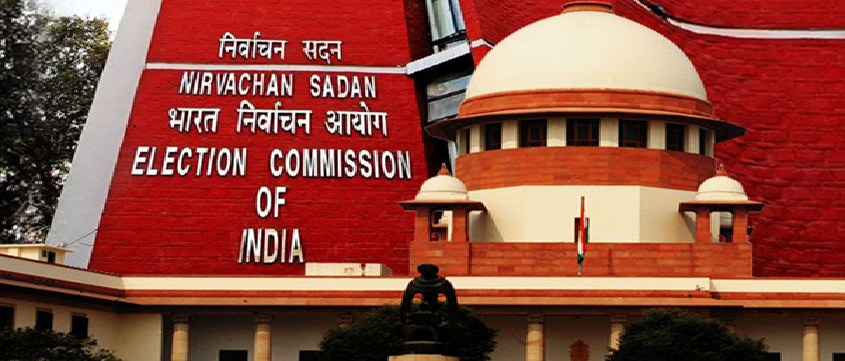
Why in News?
- A petition has been filed in the Supreme Court seeking a direction to the Election Commission of India (ECI) to seize the election symbol or de-register a political party that promises or distributes “irrational freebies” from public funds before elections.
About the News:
- It said there should be a total ban on such populist measures to gain undue political favours from the voters as they violate the Constitution and the ECI should take suitable Deterrent Measures.
Why it is Needed?
- The plea urged the court to declare that the promise of irrational freebies from public funds before elections unduly influences the voters, disturbs the level playing field and vitiates the purity of the poll Process.
- This unethical Practice is just like giving bribes to the electorate at the cost of the exchequer to stay in power and must be avoided to preserve democratic principles and practices.
Registration of Political Parties:
- Registration of Political parties is governed by the provisions of Section 29A of the Representation of the People Act, 1951.
- A party seeking registration under the said Section with the Election Commission has to submit an application to the Commission within a period of 30 days following the date of its formation as per guidelines prescribed by the Election Commission of India in exercise of the powers conferred by Article 324 of the Commission of India and Section 29A of the Representation of the People Act, 1951.
Eligibility for a ‘National Political Party of India:
- It secures at least six percent of the valid votes polled in any four or more states, at a general election to the House of the People or, to the State Legislative Assembly.
- In addition, it wins at least four seats in the House of the People from any State or States.
- It wins at least two percent seats in the House of the People (i.e., 11 seats in the existing House having 543 members), and these members are elected from at least three different States.
Eligibility for a ‘State Political Party:
- It secures at least six percent of the valid votes polled in the State at a general election, either to the House of the People or to the Legislative Assembly of the State concerned.
- In addition, it wins at least two seats in the Legislative Assembly of the State concerned.
- It wins at least three percent (3%) of the total number of seats in the Legislative Assembly of the State, or at least three seats in the Assembly, whichever is more.
What are its Benefits?
- If a party is recognised as a State Party’, it is entitled for exclusive allotment of its reserved symbol to the candidates set up by it in the State in which it is so recognised, and if a party is recognised as a `National Party’ it is entitled for exclusive allotment of its reserved symbol to the candidates set up by it throughout India.
- Recognised `State’ and `National’ parties need only one proposer for filing the nomination and are also entitled for two sets of electoral rolls free of cost at the time of revision of rolls and their candidates get one copy of electoral roll free of cost during General Elections.
- They also get broadcast/telecast facilities over Akashvani/Doordarshan during general Elections.
- The travel expenses of star campaigners are not to be accounted for in the election expense Accounts of Candidates of their Party.
Anti-Defection Law
21, Jan 2022
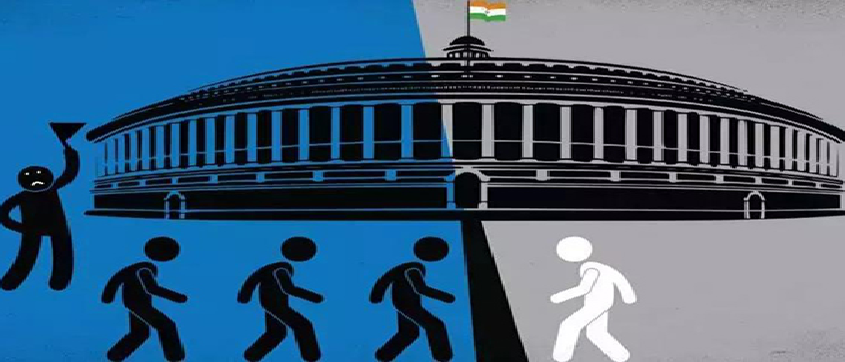
Why in News?
- Bahujan Samaj Party (BSP) chief Mayawati recently called for a more stringent anti-defection law amid a string of politicians switching parties ahead of the Uttar Pradesh Assembly Election Beginning Next Month.
What’s the Issue?
- The practice of politicians deserting Parties just ahead of elections is not unusual. And every time there are defections, the anti-defection law, which penalises individual Lawmakers for Switching Parties, comes into the Picture.
About Anti-Defection Law:
- The Tenth Schedule of Indian Constitution is popularly known as the Anti-Defection Act.
- Original constitution had no such provisions. It was included in the Constitution in 1985 by the Rajiv Gandhi government.
- The main intent of the law was to deter “the evil of political defections” by legislators motivated by the lure of office or other similar considerations.
- The grounds for disqualification under the Anti-Defection Law includes
- If an elected member voluntarily gives up his membership of a political party.
- If he votes or abstains from voting in such House contrary to any direction issued by his political party or anyone authorized to do so, without obtaining prior permission.
- Going against the Party Whip.
- As a pre-condition for his disqualification, his abstention from voting should not be condoned by his party or the authorized person within 15 days of such incident.
- Articles 102 (2) and 191 (2) deals with anti-defection.
- The law disallows MPs/ MLAs to switch parties after elections, make the members follow the whips issued by their party.It also applies to a nominated member if he/ she join a political party after 6 months of nomination and to an independent candidate if he/she joins a party after the election.
What is not a Defection?
- A split in a political party won’t be considered a defection if a complete political party merges with another political party.
- If a new political party is created by the elected members of one part.
- If he or she or alternative members of the party haven’t accepted the merger between the Two Parties and opted to perform as a separate group from the time of such a merger.
When does the 10th schedule might not apply?
- The 10th Schedule of the Indian Constitution commonly referred to as the Anti-defection Act says that disqualification on ground of defection will not apply in case of a split.
- Where a member of a House claims that he/she and any other members of his/her legislature party constitute the group representing a faction which has arisen as a result of a split in the original political party and such group consists of not less than two-thirds of the members of such legislature party, he/she shall not be disqualified.
- From the time of such split, the faction shall be deemed to be the political party to which he/she henceforth belongs.
What are the Loop-Holes?
- Resignation as MLA was not one of the conditions.
- Exploiting this loophole, the 17 rebel MLAs in Karnataka resigned, their act aimed at ending the majority of the ruling coalition and, at the same time, avoiding disqualification.
- However, the Speaker refused to accept the resignations and declared them disqualified. This was possible as the legislation empowers the presiding officer of the House (i.e. the Speaker) to decide on complaints of defection under no time constraint.
- The law originally protected the Speaker’s decision from judicial review.
- However, this safeguard was struck down in Kihoto Hollohan v. Zachillhu and Others (1992).
- While the SC upheld the Speaker’s discretionary power, it underscored that the Speaker functioned as a tribunal under the anti-defection law, thereby making her/his decisions subject to Judicial Review.
- This Judgment Enabled Judiciary to become the watchdog of the anti-defection law, instead of the Speaker, who increasingly had become a political character contrary to the expected neutral constitutional role.
- The same could be witnessed in Shrimanth Balasaheb Patel & Ors vs. Speaker Karnataka Legislative Assembly & Ors (2019), where the three-judge SC bench upheld the then Karnataka Speaker’s decision of disqualification of the 17 rebel MLAs.
- However, it struck down his ban on the MLAs from contesting elections till 2023, negating the only possible permanent solution to the problem.
- The Supreme Court played the role of a neutral umpire in this political slugfest.
- But, the spectacle of MLAs hoarded in a bus, and being sent to a resort, openly exposed not just the absence of ideological ties between a leader and his party, but also her/his weak moral character.
- It was also upsetting to see public acceptance of such malpractices as part of politics, with some even calling it Chanakya niti!
Is there Any Safeguard for Anti-Defection?
- The Anti-Defection Law provided a safeguard for defections made on genuine ideological Differences.
- It accepted “split” within a party if at least one-third of the members of the legislative party Defect, and allowed the formation of a new party or “merger” with other political party if not less than two-thirds of the party’s members commit to it.
- The 91st Constitutional Amendment introduced in 2003 deleted the provision allowing split.
- The 91st Amendment also barred the appointment of defectors as Ministers until their disqualification period is over or they are re-elected, whichever is earlier.
- But, obviously, such laws have not put to rest the trend of defections.
What Should be Done?
- The main issue, as witnessed in Karnataka, is that the defectors treat disqualification as a mere detour, before they return to the House or government by re-contesting.
- This can only be stopped by extending the disqualification period from re-contesting and appointment to Chairmanships/Ministries to at least six years.
- The minimum period limit of six years is needed to ensure that the defectors are not allowed to enter the election fray for least one election cycle, which is Five Years.
- Of course, MLAs can still be bought from the ruling dispensation to bring it to a minority by being paid hefty sums, simply to stay at home for six years.
Contradictory Reforms to the Law:
- Nowadays, no real democratic discussions happen inside political parties about major Issues affecting the country. Individual MPs and MLAs need to be empowered to think Independently.
- Anti-defection law should be applied only to confidence and no-confidence motions (Dinesh Goswami Committee on electoral reforms, 1990) or only when the Government is in danger (Law Commission (170th report, 1999).
- The rationale that a Representative is elected on the basis of the party’s programme can be extended to pre-poll alliances.
- Instead of making Speaker the authority for disqualification, the decision should be made by the president or the governor on the advice of the Election Commission. This would make the Process similar to the Disqualification procedure as given in Representation of Peoples Act (RPA).
- There can be Additional Penalties for defectors as well.
SC to consider hearing PIL challenging use of EVMs in polls
20, Jan 2022
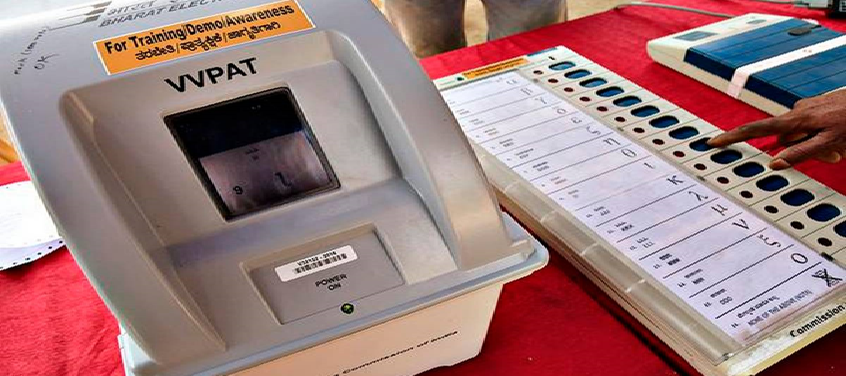
Why in News?
- The Supreme Court recently agreed to consider listing a PIL challenging the constitutional validity of a provision of the Representation of People Act which had led to the Introduction of Electronic Voting Machines (EVMs) in elections.
What does the Petition Say?
- Section 61A of the Representation of People Act, which permitted the use of EVMs, was not passed by Parliament and hence cannot be imposed. The petition wants the provision to be declared null and void.
What is an EVM?
- The Electronic Voting Machine, also known as EVM, is an electronic device used for casting votes. The EVM aims to make the electoral process secure, fair and transparent.
- The voting in India is done using electronic voting machines since 1999 to simplify the voting Process and do Away with Paper Ballots.
Can EVMs be Tampered With?
- The EVM is a tamper-proof machine. It is made of a one-time programmable chip, which cannot be connected to any external device or network such as the internet, Wi-Fi, USB or Bluetooth. Hence, it cannot be corrupted or Modified in any way possible.
What is the Process of Allotment of EVMS to Polling Booths?
- The EVMS are allotted to the polling booths through an elaborated randomization process. This way, there is no prior knowledge on which unit will go to which polling booth almost until the polling date. The machines undergo mock polls at every stage to ensure that they are in the right working condition.
How do the EVMS work?
- An EVM is designed with two units: the control unit and the balloting unit. These units are joined together by a cable.
- While the control unit of the EVM is kept with the presiding officer or the polling officer, the balloting unit is kept within the voting compartment for electors to cast their votes. This is done to ensure that the polling officer verifies your identity.
How to use an EVM?
- In order to enable the voter to cast their vote, the polling officer instead of issuing a ballot paper presses the ballot button. The balloting unit of the machine will have a list of candidate names and party symbols with a blue button next to it. The voter can press the button next to the candidate’s name they wish to vote for.
- When the Voter presses a button of his/ her choice, the machine locks itself and a printed VVPAT slip is displayed for 7 seconds before it’s automatically cut and delivered to a sealed ballot compartment. The votes are stored in the VVPAT or Voter Verifiable Paper Audit Trail machine.
- The EVM can then be opened only with a new ballot number. This way, EVMs ensure that one person gets to vote only once.
About VVPATs:
- VVPAT is a slip generated in a printer-like machine attached to EVM and shows voter’s choice of candidate as well as the party. Generated slip is displayed for a few seconds to the voter to verify before it falls into a sealed drop box which can be opened during counting.
- Advantages: Initially, election results are announced based on the recording of votes given by EVMs. If the election results are disputed, then the votes recorded under VVPATs shall be counted and announced. If there is any mismatch between the two results, then the VVPAT’s result will prevail over the EVMs.
- Disadvantages: However, VVPATs address only the issues at the voting part and the counting part still stays an opaque operation.
- Furthermore, currently, the EC’s VVPAT auditing is limited to one randomly selected polling booth per constituency. But, this sample size will not detect faulty EVMs 98-99 percent of the time.
- VVPATs can be an effective deterrent to fraud, but, the detection of even one faulty EVM in a constituency is followed by the VVPAT auditing of all the EVMs (at all booths) in that constituency = poses a serious logistical challenge and hence VVPATs are not the solution to counting Level Failures.
Why are EVMs used in India?
- The electronic voting machine came in India as a replacement to ballot papers and was first used in No. 70 Parvur assembly constituency in Kerala in 1982.
- In a large scale, the machines have been in use in India since 1999. The machines have been credited with making the voting process simpler, as now vote can be registered with just a click on the button.
- The machines are also cost-effective in the long run. Although the initial cost of an EVM is between Rs 5,000 and Rs 6,000, the machine, on an average, lasts for 15 years.
- Further, the machines run on batteries and hence don’t require electricity. They are also lighter and easily portable compared to the huge ballot boxes.
- The machines also make vote counting process faster, delivering results within hours as against Manual Counting of votes which could take days.
Punjab Lok Congress receives its Party Symbol
12, Jan 2022
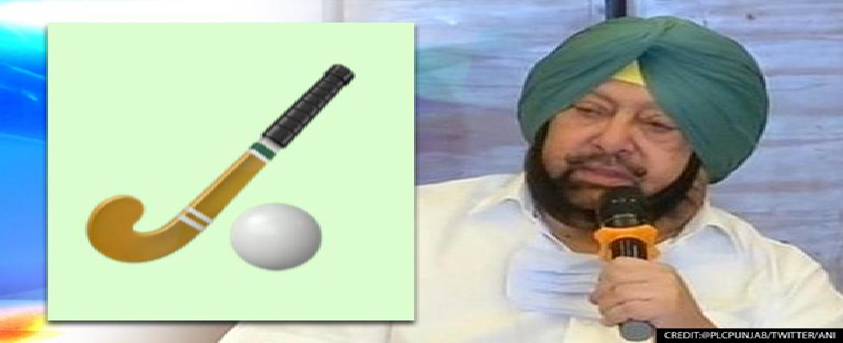
Why in News?
- Former Punjab CM Amarinder Singh’s newly formed party Punjab Lok Congress has received its party symbol – Hockey stick and ball.
Firstly, how are symbols allotted to political parties?
- As per the guidelines, to get a symbol allotted:
- A party/candidate has to provide a list of three symbols from the EC’s free symbols list at the time of filing nomination papers.
- Among them, one symbol is allotted to the party/candidate on a first-come-first-serve basis.
- When a recognised political party splits, the Election Commission takes the decision on assigning the symbol.
Powers of Election Commission:
- The Election Symbols (Reservation and Allotment) Order, 1968 empowers the EC to recognise political parties and allot symbols.
- Under Paragraph 15 of the Order, it can decide disputes among rival groups or sections of a recognised political party staking claim to its name and symbol.
- The EC is also the only authority to decide issues on a dispute or a merger. The Supreme Court upheld its validity in Sadiq Ali and another vs. ECI in 1971.
How many Types of Symbols are there?
- As per the Election Symbols (Reservation and Allotment) (Amendment) Order, 2017, party symbols are either:
- Reserved: Eight national parties and 64 state parties across the country have “Reserved” Symbols.
- Free: The Election Commission also has a pool of nearly 200 “free” symbols that are allotted to the thousands of unrecognised regional parties that pop up before Elections.
What are the Election Commission’s powers in a dispute over the election symbol when a Party Splits?
- On the question of a split in a political party outside the legislature, Para 15 of the Symbols Order, 1968, states: “When the Commission is satisfied that there are rival sections or Groups of a Recognised political party each of whom claims to be that party the Commission may decide that one such rival section or group or none of such rival sections or groups is that recognised political party and the decision of the Commission shall be binding on all such rival sections or groups.”
- This applies to disputes in recognised national and state parties (like the LJP, in this case). For splits in registered but unrecognised parties, the EC usually advises the warring factions to resolve their differences internally or to approach the court.
- Please note that before 1968, the EC issued notifications and executive orders under the Conduct of Election Rules, 1961.
Six Additional Seats for Jammu and one for Kashmir Proposed
29, Dec 2021
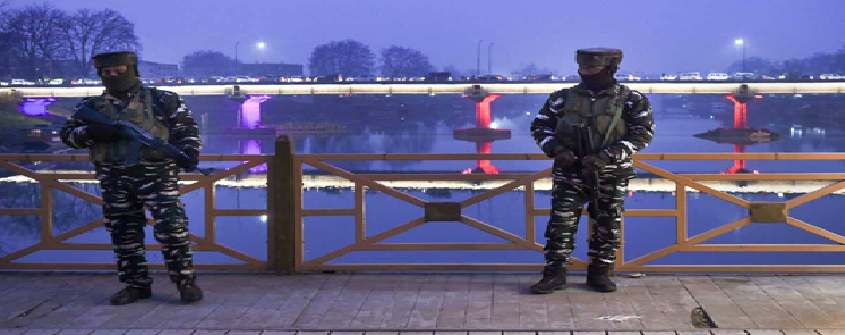
Why in News?
- The Draft Paper of the Delimitation Commission has proposed seven additional Assembly seats for Jammu and Kashmir — six in Jammu division and one in Kashmir valley.
About the News:
- For the first time, the commission proposed reserving nine seats for Scheduled Tribes (STs) on the basis of population. Seven seats are proposed for the Scheduled Caste (SC) community.
- With the proposed addition, the total Assembly constituencies in Jammu and Kashmir has risen to 90 — in Jammu, the number of seats has gone up to 43 from 37, and in Kashmir, by one seat to 47.
- An additional 24 seats are proposed to be reserved for Pakistan-occupied Kashmir (PoK).
- Of the seven additional Assembly constituencies in the Union Territory, one each has been proposed in the districts of Kathua, Samba, Rajouri, Reasi, Doda and Kishtwar in Jammu division, and Kupwara in the Kashmir valley.
What is Delimitation?
- Delimitation literally means the process of fixing limits or boundaries of territorial constituencies in a state that has a legislative body.
- Bifurcation of J&K into two UTs has led to redrawing of Assembly constituency boundaries. While, the UT of Ladakh will not have its own legislature, J&K will. This would be similar to Puducherry or Delhi.
- Such delimitation was also necessitated in 2014 when Andhra Pradesh and Telangana were bifurcated.
- According to the Delimitation Commission Act, 2002, the Delimitation Commission appointed by the Centre has to have three members: a serving or retired judge of the Supreme Court as the chairperson, and the Chief Election Commissioner or Election Commissioner nominated by the CEC and the State Election Commissioner as ex-officio members.
How Delimitation Process is done?
- Under Article 82, the Parliament enacts a Delimitation Act after every Census.
- Under Article 170, States also get divided into territorial constituencies as per Delimitation Act after every Census.
- Once the Act is in force, the Union Government sets up a Delimitation Commission.
- The new state assembly shall have 114 seats (currently 107), out of which only 90 will be open for elections, and the remaining 24 will be shadow seats reserved for the areas of the erstwhile state that have been occupied by Pakistan (PoJK).
- For the delimitation exercise, the population figures of 2011 census shall be taken as the basis.
- The J&K Representation of the People Act 1957 has now been invalidated and, instead, delimitation will be done as per the Representation of the People Act, 1950 (as amended from time to time) and provisions of Sections 59, 60 of Act 34 of 2019.
Who Carry out the Exercise?
- Delimitation is undertaken by a highly powerful commission. They are formally known as Delimitation Commission or Boundary Commission.
- These bodies are so powerful that its Orders have the force of law and they cannot be Challenged before any Court.
- Such commissions have been constituted at least four times in India — in 1952 under the Delimitation Commission Act, 1952; in 1963 under Delimitation Commission Act, 1962; in 1973 under Delimitation Act, 1972 and last in 2002 under Delimitation Act, 2002.
- The commissions’ orders are enforced as per the date specified by the President of India. Copies of these orders are laid before the Lok Sabha or the concerned Legislative Assembly. No modifications are permitted.To provide equal representation to equal segments of a population.
- Fair division of geographical areas so that one political party doesn’t have an advantage over others in an election.
- To follow the principle of “One Vote One Value”.
What are the Problems with Delimitation?
- States that take little interest in population control could end up with a greater number of seats in Parliament. The southern states that promoted family planning faced the possibility of having their seats reduced.
- In 2008, Delimitation was done based on the 2001 census, but the total number of seats in the Assemblies and Parliament decided as per the 1971 Census that was not changed.
- The constitution has also capped the number of Lok Shaba & Rajya Sabha seats to a maximum of 550 & 250 respectively and increasing populations are being represented by a Single Representative.
Lok Sabha passes Bill to Link Electoral Rolls with Aadhaar
29, Dec 2021
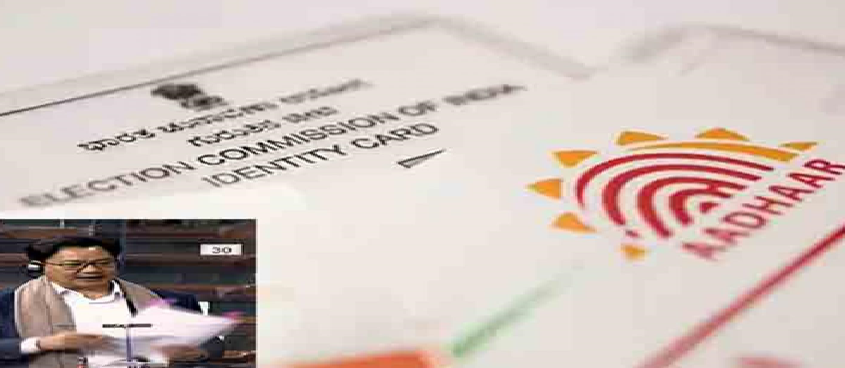
Why in News?
- The Election Laws (Amendment) Bill, 2021 that seeks to link electoral rolls to Aadhaar number has been passed by the Lok Sabha recently.
Need for linking of Aadhaar and Voter ID
- This has been a demand of the Election Commission ever since 2015.
- The EC had launched the National Electoral Law Purification and Authentication Programme to link the Aadhaar number with the voter ID number.
- It said the linking will weed out multiple enrolments in the name of one person.
- At that time, the programme was stalled as the Supreme Court ordered that the use of Aadhaar will remain optional to avail of welfare schemes.
- Following this, the EC modified its proposal and said the linking will be optional.
Other Provisions in the Bill:
- It will provide registration of new voters on four qualifying dates in place of the existing January 1 of every year.
- At present, anyone turning 18 on or before January 1 will be eligible to be registered as a voter. Anyone born after January 1 will have to get enlisted only after a year.
- According to the bill, along with January 1, there will be three other qualifying dates – April 1, July 1 and October 1 – in every calendar year.
- The amendments also allow the elections to become gender neutral for service voters.
- The amendment will help replace the word ‘wife’ with the word ‘spouse’ making the statutes “gender neutral”.
- At present, an Armyman’s wife is entitled to be enrolled as a service voter, but a woman officer’s husband is not. With ‘wife’ being replaced by the term ‘spouse’, this will change.
What are the Issues Raised Over Voter ID-Aadhaar Seeding?
- The proposal fails to specify the extent of data sharing between the ECI and UIDAI databases, the methods through which consent will be obtained, and whether consent to link the databases can be revoked.
- In the absence of a robust Personal Data protection law — a Bill in that regard is yet to clear Parliament — any move to allow sharing of data can prove to be problematic. There would be an intrusion to the privacy of the individual.
DELIMITATION PANEL FOR J&K AND NORTH EASTERN STATES
07, Mar 2020
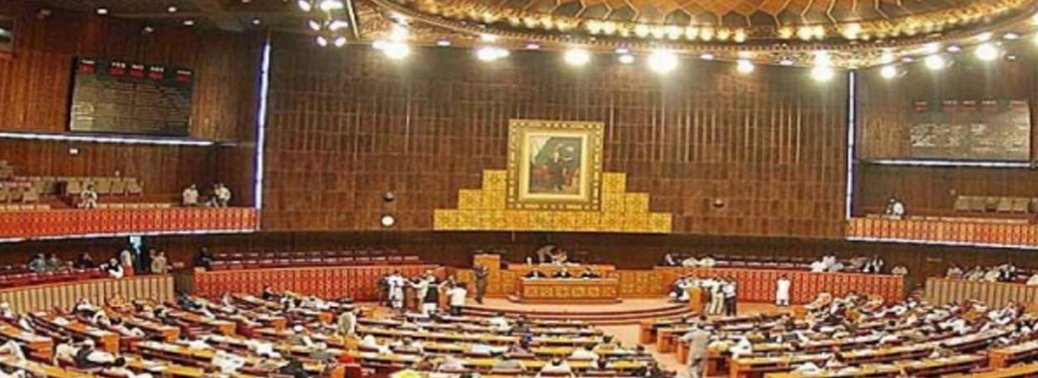
Why in News?
- The union government has started the process of redrawing the Lok Sabha and assembly constituencies in the Union Territory of Jammu and Kashmir and the northeastern states of Assam, Arunachal Pradesh, Manipur and Nagaland.
Why initiated for these Areas Alone?
- In 2002, the last delimitation was conducted across India but these states were left out due to various reasons.
What is Delimitation?
- Delimitation literally means the process of fixing limits or boundaries of territorial constituencies in a state that has a legislative body.
- Bifurcation of J&K into two UTs has led to redrawing of Assembly constituency boundaries. While, the UT of Ladakh will not have its own legislature, J&K will. This would be similar to Puducherry or Delhi.
- Such delimitation was also necessitated in 2014 when Andhra Pradesh and Telangana were bifurcated.
- According to the Delimitation Commission Act, 2002, the Delimitation Commission appointed by the Centre has to have three members: a serving or retired judge of the Supreme Court as the chairperson, and the Chief Election Commissioner or Election Commissioner nominated by the CEC and the State Election Commissioner as ex-officio members.
How Delimitation process is done?
- Under Article 82, the Parliament enacts a Delimitation Act after every Census.
- Under Article 170, States also get divided into territorial constituencies as per Delimitation Act after every Census.
- Once the Act is in force, the Union government sets up a Delimitation Commission.
- The new state assembly of Jammu and Kashmir shall have 114 seats (currently 107), out of which only 90 will be open for elections, and the remaining 24 will be shadow seats reserved for the areas of the erstwhile state that have been occupied by Pakistan (PoJK).
- For the delimitation exercise, the population figures of 2011 census shall be taken as the basis.
- The J&K Representation of the People Act 1957 has now been invalidated and, instead, delimitation will be done as per the Representation of the People Act, 1950 (as amended from time to time) and provisions of Sections 59, 60 of Act 34 of 2019.
Who carry out the Exercise?
- Delimitation is undertaken by a highly powerful commission. They are formally known as Delimitation Commission or Boundary Commission.
- These bodies are so powerful that its orders have the force of law and they cannot be challenged before any court.
- Such commissions have been constituted at least four times in India — in 1952 under the Delimitation Commission Act, 1952; in 1963 under Delimitation Commission Act, 1962; in 1973 under Delimitation Act, 1972 and last in 2002 under Delimitation Act, 2002.
- The commissions’ orders are enforced as per the date specified by the President of India. Copies of these orders are laid before the Lok Sabha or the concerned Legislative Assembly. No modifications are permitted.
Why Delimitation is Needed?
- To provide equal representation to equal segments of a population.
- Fair division of geographical areas so that one political party doesn’t have an advantage over others in an election.
- To follow the principle of “One Vote One Value”.
What are the problems with Delimitation?
- States that take little interest in population control could end up with a greater number of seats in Parliament.
- The southern states that promoted family planning faced the possibility of having their seats reduced.
- In 2008, Delimitation was done based on the 2001 census, but the total number of seats in the Assemblies and Parliament decided as per the 1971 Census that was not changed.
- The constitution has also capped the number of Lok Shaba & Rajya Sabha seats to a maximum of 550 & 250 respectively and increasing populations are being represented by a single representative.
Way Forward:
- Although the freeze on the number of seats in Lok Sabha and Assemblies should have been lifted after the 2001 Census, another amendment has postponed this until 2026.
- This was justified on the ground that a uniform population growth rate would be achieved throughout the country by 2026.
EC MOOTS LINKING AADHAAR WITH VOTER IDS
06, Mar 2020

Why in News?
- Recently the Election Commission (EC) has proposed the Law Ministry to link the Aadhaar card with the Election Photo Identity Card (EPIC) to prepare an error free electoral roll.
What is the Issue?
- The General Elections 2019 witnessed discrepancies in voter eligibility and rolls, and the resultant denial of voting rights of many.
- Migrant labours and workers are unable to vote if they are away from their homes at the time of elections.
- The disenfranchisement of voters is likely due to four factors which are discussed below, calling for Aadhaar as a solution to resolve them.
What are the Problems Faced?
1. Issues with Registration:
- Several people are unable to register to vote.
- The reasons for this range from not being aware of the registration methodology, to the process itself being inconvenient to not even knowing there is one.
- Challenges – It is the responsibility of the Election Commission of India (ECI) to inform the eligible voters who have not registered yet.
- The ECI does this via mass campaigns since it is not possible for it to exclusively identify unregistered adult citizens.
- Currently, the easiest way to freshly apply to be registered as a voter is to fill out a Form 6 on the NVSP (National Voters’ Service Portal) or the ECI’s app.
- However, this is an extremely cumbersome exercise and potentially an impediment to comprehensive voter registration efforts.
- Way out – Aadhaar can significantly simplify the process, once the ECI has ascertained that a resident is eligible to vote.
- This whole process could be replaced with a single step Aadhaar based e-KYC.
2. Problem in Voter Rolls:
- Several government functionaries have discretionary powers that empower them to remove names from voter lists.
- Additionally, the ECI has the right to disqualify citizens from voting under certain conditions as per the Constitution.
- The ECI maintains and it is indeed mandated to publish a list of people disqualified from voting in each state.However, the reasons for their disqualifications are not included and likely not recorded either.
- Concerns – There are people who have voted at a particular booth previously but have been omitted from the voter rolls.
- In many cases, the ECI does not have the contact details (or updated ones) of voters to notify them before a deletion takes place.
- The absence of contact information was due to the fact that up until recently, the ECI did not collect these details.
- In cases where they have contact details, the changes in the same are not made by voters unless the Electors Photo Identity Card (EPIC) is their de facto ID.
- Besides, the most disturbing factor is the political adventurism of parties (and politicians) and voters alike.
- There have been cases reported of voters who are registered to vote in multiple booths and, thus, can vote multiple times.
- Way Out– During registration, Aadhaar holders could give consent to the ECI to have their contact details shared.
- In that case, they could be pre-emptively notified about an impending deletion.
- The illegality of private and political actors in regards with voters roll needs to be checked.
- Here, Aadhaar’s anti-fraud and de-duplication features can be put to use.
3. Discrepancies in Details:
- Concern:Several people have been turned away from voting due to discrepancies between their details on the rolls and the ID documents they present for validation.
- Generally, people who get married or have recently changed other demographic parameters might make the necessary changes to their Aadhaars and neglect other IDs.
- Way Out –In such cases, reliance on Aadhaar will mitigate the risks of exclusion that are a consequence of demographic data mismatches.
4. Relocation:
- The most easily addressable cause of disenfranchisement is relocation.
- Concern:It is often the case that people who have made the requisite changes will feature both on the voter list of their new and previous residences.
- Way Out:Here too, it is far more likely for people to update Aadhaar rather than their EPIC.
Way Forward:
- Many of the exclusions discussed above can be remedied with Aadhaar.
- It uniquely identifies every individual in the country through all of the same details as the EPIC.
- Also, unlike EPIC, Aadhaar captures biometric data, which is useful in validating uniqueness.
- Ironically, the EPIC does not guarantee a vote; if a name does not appear on the voter rolls, she will not be permitted to vote.
- Even if a person’s name does appear on the voter rolls, the EPIC is not the only document that is accepted as proof of identity.
- Therefore, the very existence of the EPIC is worth reconsidering today.
- In this regard, the ECI publicly expressed its interest in seeding their databases with Aadhaar.
- It also attempted a drive to voluntarily link Aadhaar to voter IDs but was halted by the Supreme Court in 2017.
- There have been recent reports, however, suggesting that the ECI has been preparing to resume these activities.
- Given that Aadhaar is the only universal, de-facto identification infrastructure in India today, the move could be taken further.
POLL PANEL WORKING ON REMOTE VOTING SYSTEM
18, Feb 2020

Why in News?
- The Election Commission of India has joined hands with Indian Institute of Technology-Madras (IIT-M) to prepare an model of Aadhaar-linked electronic voting system.
- This new system will enable electors to cast their votes from any part of the country or even from abroad — irrespective of where they are registered to vote in the country.
About the New electronic voting system:
- Characteristics of the new technology
- A system for two-way remote votingin controlled environment using blockchain technology.
- If the technology is approved, will it be implemented automatically?
- If the project is given the go-ahead by the EC, election laws will have to be changed.
- Has EC used this kind of voting before?
- The ECI had used a one-way electronic system for service electors for the first time in the 2019 Lok Sabha elections.
What is One Way and Two Way Polling?
- One Way Polling:
- One-way transmission for service voters involves sending a blank postal ballot electronically to the voter. The ballot paper is downloaded, ballot cast and then sent via normal postal service to the returning officer for counting.
- Two Way Polling:
- Two-way electronic transmission of vote envisages that a registered voter from any location in India, once his identity is well authenticated will be able to cast his vote electronically through a secure encrypted system and the same will reach the designated returning officer for counting.
Significance of the New System:
- The new system enables migrants to vote from their place of residency, which saves them the time of travelling to their registered constituency and financial costs encountered.
- This model will help in increased turnout for voting, which reflects true representation of the Elected Candidate.
ELECTORAL BONDS
02, Nov 2019

Why in News?
- Association for Democratic Reform has recently stated that electoral bonds worth Rs.232 crore was sold since past October.
About Electoral Bonds:
- An electoral bond is designed to be a bearer instrument like a Promissory Note — in effect, it will be similar to a bank note that is payable to the bearer on demand and free of interest.
- It can be purchased by any citizen of India or a body incorporated in India.
- The electoral bonds will not bear the name of the donor. In essence, the donor and the party details will be available with the bank, but the political party might not be aware of who the donor is.The intention is to ensure that all the donations made to a party will be accounted for in the balance sheets without exposing the donor details to the public.
Eligibility of a Political Party:
- Every party that is registered under section 29A of the Representation of the Peoples Act, 1951 (43 of 1951) and has secured at least one per cent of the votes polled in the most recent Lok Sabha or State election has been allotted a verified account by the Election Commission of India. Electoral bond transactions can be made only via this account.
Other facts regarding Electoral Bonds:
- The bonds have been issued in multiples of Rs.1,000, Rs.10,000, Rs.1 lakh, Rs.10 lakh and Rs.1 crore and have been available at specified branches of State Bank of India.
- They can be bought by the donor with a KYC-compliant account. Donors can donate the bonds to their party of choice which can then be cashed in via the party’s verified account within 15 days.
- The bonds will be available for purchase for a period of 10 days each in the beginning of every quarter, i.e. in January, April, July and October as specified by the Central Government.
- An additional period of 30 days shall be specified by the Central Government in the year of Lok Sabha elections.
- Donations will be tax deductible, and the benefitting political party will get a tax exemption for the amount received.
Do private companies are eligible for Electoral Bonds?
- Prior to 2017, as per Section 182 of the Companies Act, 2013, a company can donate only up to 7.5% of its average profit of the last three years, and must disclose this amount and the beneficiary political party.
- Now, through the electoral bonds, there is no limit to the amount companies can donate, and the requirement for such firms to have existed for the last three years on a profit-making basis has also been deleted.
Whether foreign companies are eligible for Electoral Bonds?
- The amended Companies Act now allows any foreign company registered in India to make contributions through bonds to political parties, subject to legitimate doubts about who or where its real owners are, or what its source of funding is.
About ADR:
- The Association for Democratic Reforms (ADR) is an Indian non-partisan, non-governmental organization which works in the area of electoral and political reforms.
- Along with National Election Watch (NEW), ADR is striving to bring transparency and accountability in Indian politics and reducing the influence of money and muscle power in elections.
- In the last few years, based on ADR’s report and data, a huge number of coverage was received in print and online media.
ELECTRONICALLY TRANSMITTED POSTAL BALLOT SYSTEM (ETPBS)
22, Jul 2019
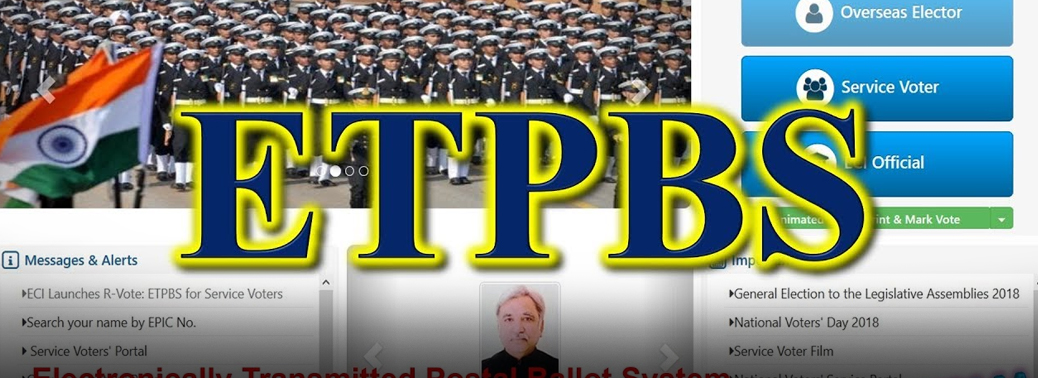
Why in News?
- In the recently concluded 2019 general elections, the Election Commission of India used Electronically Transmitted Postal Ballot System (ETPBS) for service voters.
Electronically Transmitted Postal Ballot System (ETPBS):
- Persons working in Central Forces under Arms Act and Government officials deployed in Embassies outside the country are classified as Service Voters.
- Such service voters are provisioned for online enrolment.
- On the introduction of the ETPBS, there has been a record turnout of service voters. 18,02,646 were enrolled as Service Electors in 2019. This is a high of 60.14% as recorded by the E-postal ballot.
- The number of service voters included those from the Ministry of Defence, Ministry of Home Affairs (Central Armed Police Forces), Ministry of External Affairs and the State Police.
- ETPBS is developed by Election Commission of India with the help of Centre for Development of Advanced Computing (C-DAC).
- This system enables the entitled service voters to cast their vote using an electronically received postal ballot from anywhere outside their constituency. The voters who make such a choice will be entitled for Postal Ballot delivered through Electronic Media for a particular election.
- It enables the voters to cast their vote on an electronically received postal ballot from their preferred location, which is outside their originally assigned voting constituency.
- This system addresses the issue of time constraint for dispatch of postal ballot.
Who are eligible to avail of ETPBS?
- Service Voters, other than those who opt for proxy voting (Classified Service Voters)
- The wife of a Service Voter who ordinarily resides with him
- Overseas Voters
Advantages of ETPBS:
- It can be availed by service voters from anywhere outside their constituency.
- It is easy and efficient.
- It facilitates the creation of service voter electoral roll data.
- It has two-layered security and is a secure system.
- OTP is required to download encrypted Electronically Transmitted Postal Ballot file.
- Secrecy is maintained and no duplicate of casted ETPB is possible due to QR code.
- PIN is required to decrypt, print and deliver ETPB.
Epistocracy
19, Jun 2019
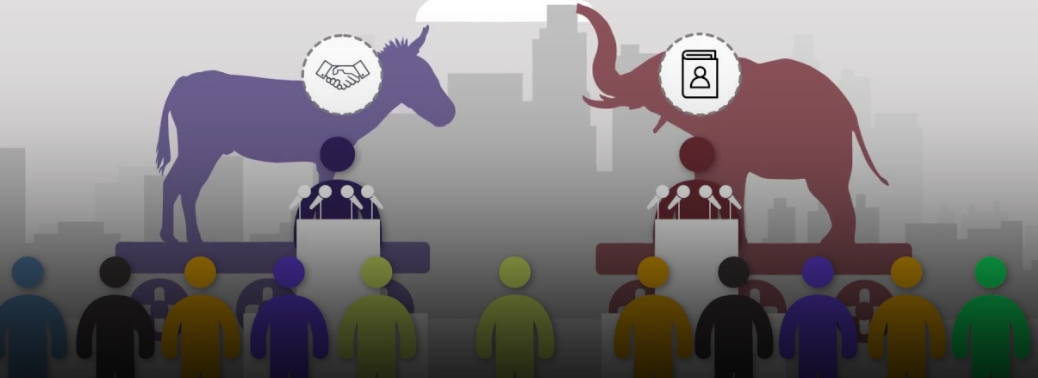
- Epistocracy is a system in which the votes of people who can prove their political knowledge count more than the votes of people who can’t.
- In other words, it’s a system that privileges the most politically informed citizens.
FROM PLATE TO PLOUGH: THE FARM-FACTORY CONNECT
11, Jun 2019
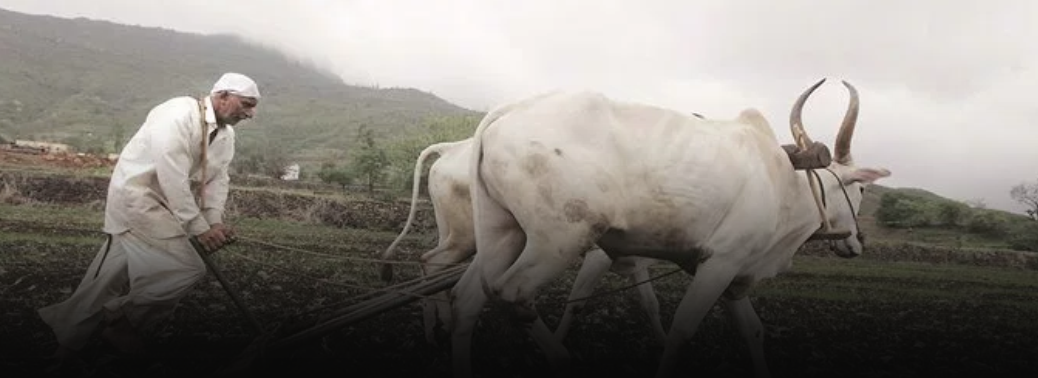
Why in News:
- Ashok Gulati, chair professor for agriculture at ICRIER, talked about importance of farm- factory connect.
Background: / Important Analysis:
- As per the last report of National Statistical Office (NSO) released on May 31, the Gross Value Added (GVA) at basic prices (2011-12 prices) for the fourth quarter (Q4) of 2018- 19 has slumped to -0.1 percent for agriculture, forestry and fishery.
- However, Agri-GDP grew at 2.9 per cent per annum in Last five year.
China Story:
- Dr Gulati observe that the first thing Chinese government did in 1978, when it started off economic reforms was to reform agriculture.
- Agri-GDP in China grew at 7.1 per cent per annum during 1978-84, and because the Chinese government also liberated price controls on Agri-commodities, farmers’ real incomes increased at 15 per cent per annum.
- China registered an Agri-GDP growth of 4.5 per cent per annum during 1978-2016
- This helps the manufacturing revolution, which was revved up through town and village enterprises (TVEs) to cater to domestic demand from rural areas.
Indian Story:
- India has never had any major Agri-reforms and farmers’ incomes have remained very low. It has implications not only for overall Agri-GDP growth, but also for slowing down of manufacturing growth due to sluggish demand for industrial products in rural areas Recently, Indian industry is complaining that the rural demand is collapsing. Tractor sales are down by 13 per cent, two-wheeler sales are down by 16 per cent, car sales are down by similar percentage, and even FMCG (fast move consumer goods) sales are down in April 2019 over April 2018.
Reason for low farm productivity:
- Restrictive policies: Our restrictive policies constrain the private sector to make Indian agriculture globally competitive.
- Our restrictive policies constrain the private sector from building direct supply chains from farms to ports, which bypass the mandi system. This leads to a weak infrastructure for agri-exports.
- Obsessive focus on inflation targeting: An obsessive focus on inflation targeting by suppressing food prices through myriad controls works against the farmer.
- MSPs remain largely ineffective: Normally, MSPs remain largely ineffective for most commodities in larger parts of India. But even if they are operational through massive procurement operations, a policy of high MSPs can backfire when it goes beyond global prices.
- Take the case of rice. India is the largest exporter of rice in the world, exporting about 12 to 13 MMT of the cereal per year.
- If the government raises the MSP of rice, by say 20 per cent, rice exports will drop and stocks with the government will rise to levels far beyond the buffer stock norms.
- It would be a loss of scarce resources. Besides, it would create unnecessary distortions adversely impacting the diversification process in agriculture towards high-value crops.
- Low investment in Agri-R&D and its extension from lab to land: Today, India spends roughly 0.7 per cent of Agri-GDP on Agri-R&D and extension together. This needs to double in the next five years.
- The meagre investments in Pusa Basmati 1121 and 1509, for example, have yielded basmati exports between $ 4 and 5 billion annually.
- Investment in managing water efficiently
- Investment in infrastructure for agri-exports value chains.
NATIONAL PEOPLE’S PARTY IS NOW A NATIONAL PARTY
11, Jun 2019

Why in News:
- National People’s Party, has been recognised as a “national party”.
More in News:
- NPP is eighth party to get that recognition after Congress, BJP, BSP, NCP, CPI, CPI(M) and Trinamool Congress and the first from the Northeast
The Election Commission lists political parties as “national party”, “state party” or “registered (unrecognised) party”. - The conditions for being listed as a national or a state party are specified under the Election Symbols (Reservation and Allotment) Order, 1968.
- Previously, the poll body used to assess the eligibility based on the performance in one election, but in 2016, it altered the rules to expand the assessing period to two elections (this could be one general election and one state one; or two general elections; or two state ones) after the one in which it was granted a national party or regional party status.
National Party:
- For any political party to be eligible for recognition as a national Party, it has to satisfy any of these conditions
6% vote share in the last Assembly polls in each of any four states, as well as four seats in the last Lok Sabha polls; or
2% of all Lok Sabha seats in the last such election, with MPs elected from at least three states; or - Recognition as a state party in at least four states.
- Note – The NPP has satisfied the last of these conditions. It is recognised as a state party in four states — Arunachal Pradesh, Manipur and Nagaland, besides Meghalaya.
- It has earned that recognition by fulfilling different conditions in different states.
- For recognition as a state party, any one of five conditions need to be satisfied. These are specified under paragraph 6A of the 1968 Order:
- Two seats plus a 6% vote share in the last Assembly election in that state; or One seat plus a 6% vote share in the last Lok Sabha election from that state; or
- 3% of the total Assembly seats or 3 seats, whichever is more; or
- One of every 25 Lok Sabha seats (or an equivalent fraction) from a state; or
- An 8% state-wide vote share in either the last Lok Sabha or the last Assembly polls.
- In Meghalaya, the NPP easily satisfies all five conditions, with 19 Assembly seats out of 59 and a 20.60% vote share in 2018, followed by one of the state’s two Lok Sabha seats and a 22% vote share this year.
- In the other three states, it did not win a single Lok Sabha seat or get an 8% vote share in any, but earned recognition as a state party by virtue of its Assembly poll performances.
- In Manipur, it won four seats in 2017,which satisfied condition (iii) listed under Paragraph 6B. In Assembly elections to Nagaland last year and Arunachal this year, the NPP fulfilled the conditions (i) and (iii).
RECORDING DISSENTING OPINION IN EC
24, May 2019
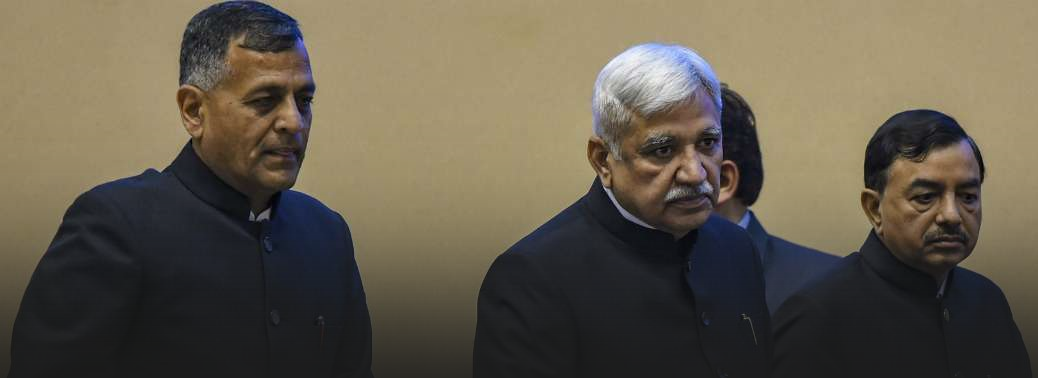
Why in News?
- The Election Commission has decided by majority that dissenting opinions in Model Code of Conduct (MCC) disputes will not be made part of any final order.
- What was the dispute?
- Election Commissioner Ashok Lavasa had given dissenting opinion in at least four cases. These related to cases where the ECI (2:1 majority) did not find any violation in the speeches of PM Narendra Modi and BJP chief Amit Shah.
- Election Commissioner Ashok Lavasa had written thrice to the Chief Election Commissioner Sunil Arora in this regard.
- He had conveyed his decision to stay away from proceedings related to the MCC if the dissenting views were not incorporated in the orders.
- With ECI’s recent decision, the dissenting opinions will only be included in internal files, as per previous practice.
What does the law say?
- Article 324 of the Constitution vests the superintendence, direction and control of elections in an Election Commission of India.
- It consists of the Chief Election Commissioner and such number of other Election Commissioners, if any, as the President may from time to time fix.
- At present the Election Commission is a multi-member body, with a Chief Election Commissioner and two other members.
- The law requires the multi-member EC to transact business unanimously as far as possible. All three Commissioners now have equal decision-making powers.
What is the procedure in case of dissent?
- Where there is a difference of opinion, decision is taken by majority.
- All opinions carry equal weight, which means the CEC can be overruled by the two ECs.
- If some difference of opinion persists even after oral deliberations and discussions, such dissent is recorded in the file.
- In normal practice, while communicating the decision of the Commission in executive matters, the majority view is conveyed to the parties concerned.
The dissent remains recorded in the file. - In case dissent is to be recorded in a case of judicative nature, the dissenting member may like to record a separate opinion/order.
- However, despite the existence of the provision to take decisions by majority since 1993, very rarely has dissent been recorded.
- When a matter is deliberated upon by the 3 Commissioners, they normally agree to a common course of action.
- This does not, however, mean that there is no disagreement between the Commissioners.
Is the rejection of the demand justified?
- The recent rejection of the demand of Mr. Lavasa on recording dissenting opinions in the orders may be technically and legally right.
However, there was indeed a strong case for acceding to his demand. - This is especially true at least in regard to complaints against high functionaries such as the Prime Minister. The EC has been widely criticised for giving a series of ‘clean chits’ to the PM.
- This was despite some questionable remarks that appeared to solicit votes in the name of the armed forces. Added to the dispute was the unexplained delay of several weeks in disposing of complaints against Mr. Modi. It is in this context that Mr. Lavasa’s dissenting opinion may have been relevant enough to merit inclusion in the EC’s orders.
- People are entitled to know whether or not the poll panel’s key decisions are unanimous. In the present case, Mr. Lavasa has taken up the issue through as many as three letters. So it is reasonable to infer that there is some basis for his grievance.
- The onus on EC to maintain a level-playing field and enforce the election code is quite high, especially when its credibility is under question.
- It would be unfortunate if the majority in the EC were to be afraid of any public reaction that may result from disclosure of a split opinion.
ONLY A MARGINAL CHANGE IN NOTA VOTE PERCENTAGE
24, May 2019
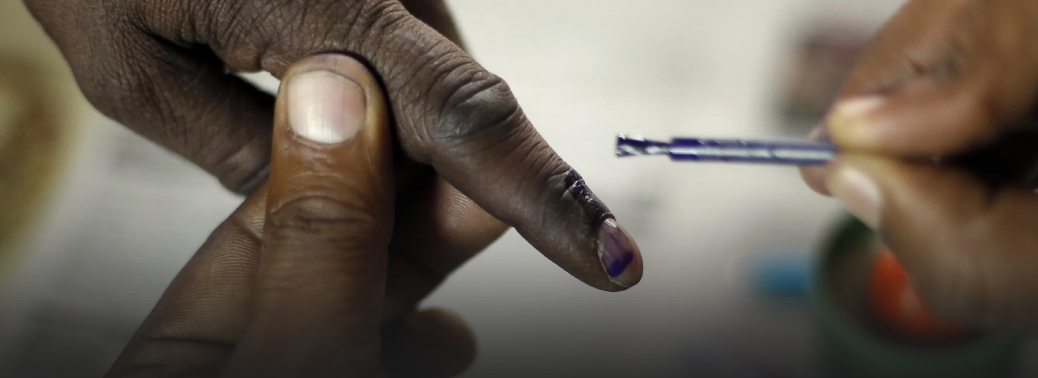
Why in News:
The percentage of votes for NOTA, or the none-of-the-above option, this year has remained virtually unchanged from last time, according to data from the Election Commission (EC) website.
background:
- In 2019, about 1.04% of the voters felt that none of the candidates deserved their vote. In the 2014 Lok Sabha election, this was around 1.08% of the voters.
- The 2019 Lok Sabha elections stretched over six weeks and registered the highest voter turnout in the history of the Lok Sabha election.
NOTA:
- None Of The Above (NOTA) is a ballot option designed to allow the voter to indicate disapproval of all of the candidates in a voting system.
- It was introduced in India following the 2013 Supreme Court directive in the People’s Union
for Civil Liberties v. Union of India judgment. - However, NOTA in India does not provide for a ‘right to reject’.
- The candidate with the maximum votes wins the election irrespective of the number of NOTA votes polled.
What is the current pattern of NOTA?
- NOTA polling figures are still small.
- In the 2013 Assembly elections held in four States NOTA constituted 1.85% of the total votes polled.
- Then it dropped to 0.95% in the 2014 Assembly elections held in eight States.
- It increased to 2.02% in the 2015 Assembly elections held in Delhi and Bihar. While Delhi polled a mere 0.40%, Bihar saw 2.49% of NOTA votes, which remains the highest NOTA votes polled so far in any State in Assembly elections.
- The number of NOTA votes polled was larger than the winning margin in 261 Assembly constituencies and in 24 constituencies in the Lok Sabha elections since 2013.
- Therefore, in these constituencies the NOTA votes did make a difference to the election results. Reserved constituencies – Reserved constituencies have seen a relatively larger number of NOTA votes. This point to the continued social prejudice against political reservation for SC/STs. Left-Wing Areas – Constituencies affected by left-wing extremism have also recorded higher NOTA performance and here probably it served as an instrument of protest against the State itself.
- Mainstream Parties – It is comparatively higher in the constituencies which have seen a direct contest between the Congress and the Bharatiya Janata Party. This might be some indication of the people’s disenchantment with two mainstream political parties.
- NOTA is also used to express their protest against many things they perceive wrong in the political system.
What is the way ahead?
- So far, a small number of Indian voters have come to see NOTA as an instrument of protest. The perceived cynicism of Indian voters against the political class thus seems exaggerated. Nevertheless, it is important to note that these voters have used the democratic means of NOTA to express their resentment rather than boycotting the polls outright. This electoral option will become a meaningful means of negative voting only if it becomes a ‘right to reject’ rather than being a symbolic instrument to express resentment as it is now.
ELECTION COMMISSION REJECTS OPPOSITION PARTIES’ DEMAND ON VVPAT VERIFICATION
23, May 2019

Why in News:
The Election Commission (EC) rejected the demand of Opposition parties for tallying of the Voter Verified Paper Audit Trail (VVPAT)
Background: / What is a VVPAT system?
- Voter verifiable paper audit trial (VVPAT) is an independent system attached to an EVM that allows the voters to verify that their votes are cast as intended.
- When a vote is cast, a slip is printed on the VVPAT printer containing the serial number, name and symbol of the candidate voted.
- This remains visible to you through a transparent window for seven seconds.
- Thereafter, this printed slip automatically gets cut and falls into a sealed drop box.
- If there is a need, these printouts can later be counted.
How did the VVPAT system evolve in India?
- Many political parties expressed their satisfaction with EVMs initially.
- But some parties requested the Commission to consider introducing VVPATs for further transparency and verifiability of the votes cast.
- The Commission referred the matter to its technical committee on EVMs to examine and make a recommendation to the Commission.
- The committee first met with the manufacturers and then with political parties and other civil society members to explore the design requirements of the VVPAT system.
- In 2011, BEL and ECIL made a prototype of the VVPAT and demonstrated it to the technical committee and the Election Commission.
- In the same year the Commission conducted simulated elections for the field trial of the VVPAT system in various places including Thiruvananthapuram, Ladakh, Cherrapunji and Jaisalmer.
- Two years later, the government amended the Conduct of Elections Rules, 1961 allowing the Commission to use VVPATs along with EVMs.
- These were first used in the bye-election for the Noksen Assembly seat in Nagaland in 2013. Thereafter VVPATs have been used in select constituencies in every election to the State Assemblies.
- They were deployed in eight Parliamentary constituencies during the 2014 Lok Sabha elections. In the 2019 Lok Sabha elections, VVPATs will be used in all the constituencies.
Why is it important?
- In the world’s largest democracy, every vote counts and the EVMs and VVPATs try and ensure that the massive election process is in tune with the latest technological advancements. The Election Commission has never doubted the workings of EVMs and their utility in a free and fair electoral process.
- However, VVPATs add another layer of transparency and reliability to convince voters about the sanctity of EVMs. EVMs and VVPATs also quicken the election process as counting votes on EVMs takes much lesser time than counting paper ballots.
- The EVMs and VVPATs are also environment-friendly as they use very little paper compared to paper ballots.
TALLY EVM-VVPAT SLIPS BEFORE FINAL COUNTING, OPPOSITION TELLS EC
22, May 2019
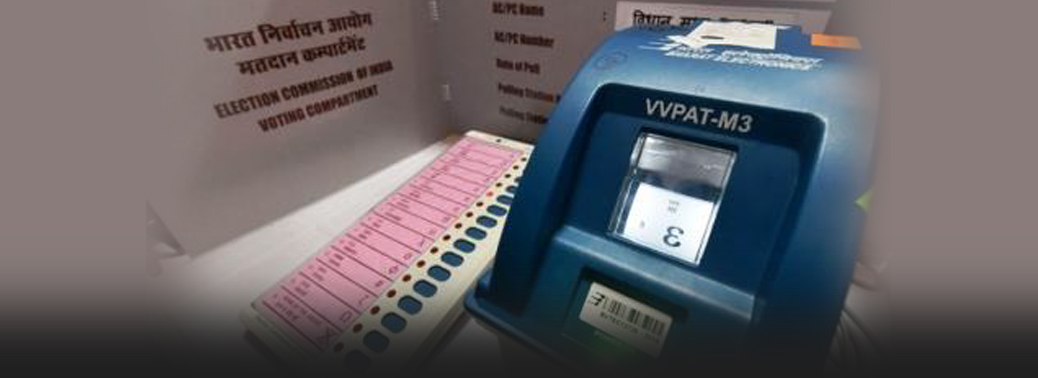
Why in News:
- Twenty-two Opposition parties met the Election Commission (EC) demanding that tallying of the Voter Verified Paper Audit Trail (VVPAT) slips in five polling booths in each Assembly segment with the electronic voting machines (EVMs) be done prior to the counting of votes.
Details:
- If any discrepancy is found anywhere in the VVPAT verification, hundred per cent counting of paper slips of VVPATs of all polling stations of that Assembly segment should be done, the parties demanded.
- The EC, however, remained non-committal and told them that there would be a special meeting of the full Commission to examine the issue.
Electronic voting machines (EVMs)
- An EVM consists of a “control unit” and a “balloting unit”. The control unit is with the Election Commission-appointed polling officer; the balloting unit is in the voting compartment into where voter casts her vote in secret.
- It runs on a single alkaline battery fitted in the control unit, and can even be used in areas that have no electricity.
- They are manufactured by Electronics Corporation of India Limited (ECIL) and Bharat Electronics Limited (BEL).
- VVPATs are an independent verification system designed to allow voters to verify that their votes were cast correctly, to
- detect possible election fraud/malfunction and to provide a means to audit the stored results in case of disputes.
Voter Verified Paper Audit Trail (VVPAT)
- In VVPATs, a paper slip is generated bearing serial number, name and symbol of the candidate along with recording of vote in CU. The printed slip is visible (for 7 seconds) in a viewing window attached to BU in voting compartment.
- In Subramaniam Swamy vs ECI (2013), SC said VVPAT is necessary for transparency in voting and must be implemented by ECI.
OPPOSITION TO MEET ECI TODAY OVER VVPAT VERIFICATION
21, May 2019

Why in News:
- Leaders of Opposition parties will meet Election Commission (EC) officials to urge the panel to spell out the mechanisms to address any mismatch between voter-verified paper audit trail (VVPAT) and electronic voting machine (EVM) tallies during the counting of votes.
Details:
- Opposition parties had suggested that if there is a discrepancy, then the votes of the entire Assembly segment should be counter-checked with the VVPAT machines.
- It is said that any discrepancy would raise a doubt on the integrity of the entire electoral process and the EC is yet to bring out the guidelines it promised.
Background:
VVPAT system
- Voter verifiable paper audit trial (VVPAT) is an independent system attached to an EVM that allows the voters to verify that their votes are cast as intended.
- When a vote is cast, a slip is printed on the VVPAT printer containing the serial number, name and symbol of the candidate voted.
- This remains visible to you through a transparent window for seven seconds.
- Thereafter, this printed slip automatically gets cut and falls into a sealed drop box. If there is a need, these printouts can later be counted.
- It is intended as an independent verification system for EVM designed to
- • allow voters to verify that their votes are casted correctly,
- • detect possible election fraud or malfunction and
- • Provide a means to audit the stored electronic results.
Advantages in VVPATs:
- Enables to verify vote: Instant feedback to voter that vote polled has been allocated to the intended candidate.
- Enables authorities to count the votes manually if there is a dispute in the electronically polled votes. Operates under a Direct Recording Election system (DRE) which detects fraud and existent malfunctions. Will ensure greater transparency in voting process.
- Gives both the voters and political parties an assurance.
SC TURNS DOWN OPPOSITION PLEA FOR INCREASED VVPAT VERIFICATION
08, May 2019
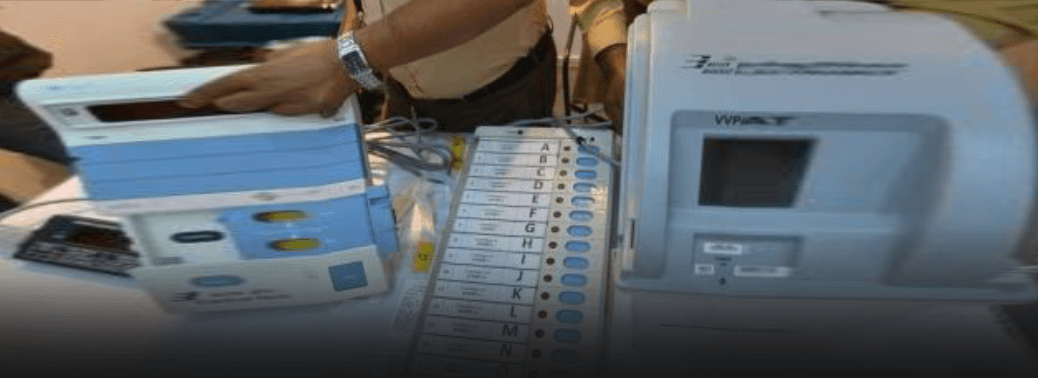
Why in News:
- The Supreme Court on Tuesday dismissed a plea by 21 Opposition parties to review its judgment rejecting 50% random physical verification of Electronic Voting Machines (EVMs) using Voter-Verified Paper Audit Trail (VVPAT).
Details
- On April 8, a Bench led by Chief Justice Ranjan Gogoi had directed the Election Commission of India (ECI) to increase physical counting of VVPAT slips to five random EVMs in each Assembly segment/constituency.
Fool-proof’ polls
- Its April verdict, the court had assured the petitioners, would ensure a ‘fool-proof’ Lok Sabha polls 2019.
- The Opposition had found the Supreme Court’s April 8 verdict a far shot from what it
- wanted — VVPAT verification in 50% or 125 polling booths in each constituency.
- The physical scrutiny of slips in five EVMs has increased the VVPAT verification percentage from .44% to less than 2%.
VVPAT
- Voter-verified paper audit trail (VVPAT) is a device which dispenses a slip with the symbol of the party for which a person has voted for. The slip appears on a small window for seven seconds and then drops in a box. The voter cannot take it home. VVPAT displays
- candidate’s serial number. Name of the candidate and Corresponding symbol for whom the vote has been cast.
Advantages in VVPATs:
- Enables to verify vote: Instant feedback to voter that vote polled has been allocated to the intended candidate.
- Enables authorities to count the votes manually if there is a dispute in the electronically polled votes.
- Operates under a Direct Recording Election system (DRE) which detects fraud and existent malfunctions.
- Will ensure greater transparency in voting process. Gives both the voters and political parties an assurance.
M3 EVMs
- M3 EVMs are the third generation EVMs. The M3 EVMs can keep data of 384
- candidates. M3 EVMS also has added features like Tamper Detection and Self Diagnostics. The tamper detection feature makes an EVM inoperative the moment anyone tries to open the machine. The Self diagnostic feature checks the EVM fully every time it is switched on. Any change in its hardware or software will be detected.
CHALLENGING ELECTORAL BONDS
07, Apr 2019

Why is it in News?
- The Election Commission of India, in an affidavit filed in the court, said the electoral bonds had made political funding opaque and would have “serious repercussions on transparency of political funding” owing to its anonymous nature.
What is electoral bond scheme?
- It is an attempt to “cleanse the system of political funding in the country.” A donor may buy an electoral bond at specified banks and branches using electronic modes of payment and after having completed the KYC (know your customer) requirements.
Where are they available?
- The electoral bonds are available at specified branches of the State Bank of India (SBI) for 10 days each in the months designated by the government from time to time. The bonds may be bought for any value, in multiples of ₹1,000, ₹10,000, ₹1 lakh, ₹10 lakh or ₹1 crore.
Why controversy?
- The bone of contention over the electoral bond scheme is that while the government has consistently said the scheme will increase transparency in electoral funding, it has ignored the reservations of several political parties and even the Election Commission.
- The parties do not have to disclose where their money comes from, as long as the mode of funding is through electoral bonds. This provision, to exempt parties from declaring the sources of the electoral bonds they receive, was done through an amendment to the Representation of the People Act by the Finance Act, 2017. Another amendment that has been criticised is the one to the Foreign Contribution Regulation Act (FCRA), which the Election Commission said will allow political parties to receive funding from foreign companies with a majority stake in Indian companies.
Are people using these bonds?
- Data revealed through the Right to Information replies by the State Bank of India show that large sums have been bought through electoral bonds. A separate RTI reply by the SBI has shown that the bank had sold ₹222 crore worth of electoral bonds in March 2018, the only month in financial year 2017-18 when these bonds were sold.
RELEASE OF MODI BIOPIC PUT OFF
05, Apr 2019
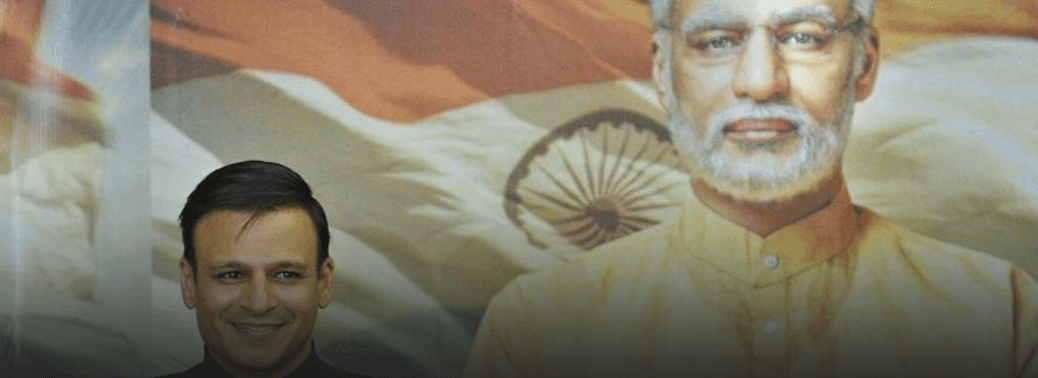
Why is it in News?
- SC agreed to urgently clear a plea on Modi biopic. It further said the biopic is meant to manipulate the voters in violation of model code of conduct in place for Lok Sabha polls.
Model code of conduct:
- The Model Code of Conduct is a set of guidelines issued by the Election Commission of India to regulate the conduct of political parties and their candidates in the run up to elections and is aimed at ensuring free and fair elections.
When did it come about?
- The MCC was first proposed by Kerala in its 1960 assembly elections.
- It was later adopted by the Election Commission of India (EC) during mid-term elections in 1968 and 1969.
- It has since been updated many times based on cases fought in courts.
- EC first issued a Model Code of Conduct for political parties at the time of the fifth general elections, held in 1971.
- The Code has evolved over the years to include behaviour norms for the party in power and the public servants who report to it.
Key features:
- General conduct of candidates
- Candidates’ meetings/processions
- Appointment of observers
- Maintenance of polling booths on the day
- Contents in election manifestos
- The Code of Conduct comes into force immediately after the elections are announced by the EC. It applies to political parties, their candidates and polling agents, the government in power and all government employees. Public places for holding election rallies and helipads for flights in connection with elections are to be made available to all parties on the same terms and conditions on which they are used by the party in power. Ministers and other government authorities should not announce any financial grants to the people; they should not lay foundation stones for or inaugurate any projects; they should not promise public facilities like roads; and they should not make any ad hoc government appointments.
Is it legally binding?
- The Model Code of Conduct does not have any statutory backing.
- But the Code has come to acquire significance in the past decade, because of its strict enforcement by the EC. Some of the more serious offences listed in the Code have also found their way into the statute books. So, for some of the offences mentioned, candidates can be tried under the Indian Penal Code or the Representation of the People Act 1951.
Representation of Peoples Act provides for the following:
- Qualification of
- Preparation of electoral
- Delimitation of
- Allocation of seats in the Parliament and state
Election commission of India
- The Election Commission of India, abbreviated as ECI is a constitutional body responsible for administering elections in India. It was established on January 25, 1950. The major aim of election commission of India is to define and control the process for elections conducted at various levels, Parliament, State Legislatures, and the offices of the President and Vice President of India. According to Article 324 of Indian Constitution, the Election Commission of India has superintendence, direction, and control of the entire process for conduct of elections to Parliament and Legislature (state legislative assembly & state legislative council) of every State and to the offices of President and Vice-President of India.
Appointment & Tenure of Commissioners:
The President has the power to select Chief Election Commissioner and Election Commissioners. They have tenure of six years, or up to the age of 65 years, whichever is earlier.
They have the same status and receive pay and perks as available to Judges of the Supreme Court of India. The Chief Election Commissioner can be removed from office only through accusation by Parliament
Key functions of the Election Commission of India:
- The Election Commission of India is considered the guardian of free and reasonable elections. It issues the Model Code of Conduct in every election for political parties and candidates so that the decorum of democracy is maintained.
- It regulates political parties and registers them for being eligible to contest elections.
- It publishes the allowed limits of campaign expenditure per candidate to all the political parties, and also monitors the same.
- The political parties must submit their annual reports to the ECI for getting tax benefit on contributions. It guarantees that all the political parties regularly submit their audited financial reports.
Simultaneous Election
29, Jul 2018
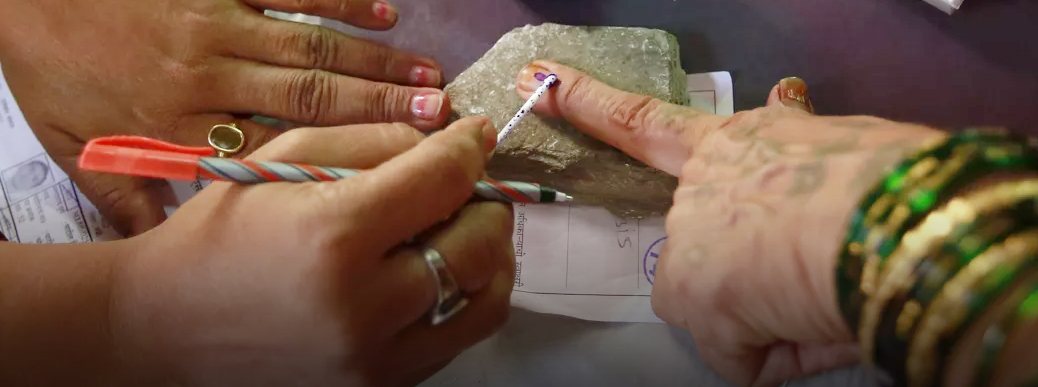
Meaning:
Simultaneous elections should imply that elections to all the three tiers of constitutional institutions take place in a synchronized and co-ordinated fashion. What this effectively means is that a voter casts his vote for electing members for all tiers of the Government on a single day.
The third tier institutions is primarily a State subject as per the Constitution. Further, considering the facts that elections to the third tier institutions are directed and controlled by the State Election Commissions and their sheer numbers in the country is significantly large.
So the term “Simultaneous Elections” in India’s context is elections to Lok Sabha and State Assemblies are held together. In such a scenario, a voter would normally cast his/her vote for electing members of Lok Sabha and State Assembly on a single day and at the same time.
Simultaneous elections at the Parliament and state assemblies’ level have been mooted out by many as a remedy to this problem of Indian democracy.
History:
- The concept of simultaneous elections is in-fact not new to the India.
- The first election after Independence was held simultaneously for the Parliament and State Assemblies in 1952. The practice was followed without any hitch in three subsequent elections held in 1957, 1962, and 1967.
- Things after 1967 changed. Due to irresponsible and politically motivated use of article 356, many state assemblies were dissolved in between leading to finalisation of this delinking process.
Relevant Constitutional and Statutory provisions:
Lok Sabha and Rajya Sabha:
- Article 83 of the Constitution of India provides for the tenure of both Houses of the Parliament (Lok Sabha and Rajya Sabha).
- Article 83(2)11 provides for a term of five years for Lok Sabha, from the date of its first sitting unless dissolved earlier.
- Article 83 (2) of the Constitution provides that when a proclamation of emergency is in operation, the term of the House may be extended for a period not exceeding one year at a time by Parliament by law and not extending in any case beyond a period of six months after the Proclamation has ceased to operate.
State Legislation:
- Article 172 (1) provides for five year tenure for State Legislative Assembly from the date of its first sitting.
- Article 172 (1) deals with state legislation during emergency period.
Election Commission:
- Article 324 mandates the Election Commission of India (ECI) to supervise, direct and control elections to Lok Sabha & State Legislative Assemblies.
- Besides the above, to facilitate the conduct of elections by the Election Commission of India, the Parliament has enacted the Representation of People Act, 1950 and Representation of People Act, 1951 and the Rules framed there under, viz., Registration of Electors Rules, 1960 and Conduct of Election Rules, 1961.
Current system of Holding Elections:
- Frequent electoral cycles disrupt normal public life by impacting the delivery of essential services. They also provide opportunities to unscrupulous elements to create tears in the social fabric of society.
- In terms of governance and implementation of development programmes, enforcing the Model Code of Conduct (MCC) is detrimental.
- Frequent elections pose a huge burden on resources — both manpower and financial.
- The cost of elections runs into thousands of crores and has been rising steadily. The opportunity cost of these lost resources is too high to ignore as India is a resource-constrained developing economy. The expenses incurred by the Government in preparation of electoral rolls, I-cards, election booths & officers etc is significant.
Rising Electoral Expenditure for the Political Parties:
- The political parties exhausted huge crore on publicity, travel and on other expenses and many crore on expenditure towards candidates.
- It’s a burden for the government, taxpayers, political parties and the candidates.
Lack of bold decision-making:
- Electoral compulsions change the focus of policy making.
- If a party which is in power at centre loses election in a state, it is projected by the opposition as the results have made severe dent on its mandate to rule. This also leads to loss of confidence in the ruling regime. A negative atmosphere is created which contributes in affecting the governance of the country in an adverse way.
- A loss in a state election in the middle of the tenure of a government at national level is rapidly projected as a loss of credibility and hence all efforts are made by the strengthened opposition to stall any new reform measures.
Security issues:
- Security personnel comprising paramilitary forces and state police officers across the country to protect polling stations and safeguard election.
- Security personnel and government officials are effectively put on election duty for many months in a year. A case in point is the recurring engagement of teachers for election duty, as a result of which students suffer.
- Elections may also lead to loss of lives at many places.
- With the elections happening so often, these features have become a recurrent theme of our democratic process.
- Frequent elections disrupt normal public life. Holding of political rallies disrupts road traffic and also leads to noise pollution.
- Frequent elections perpetuate caste, religion and communal issues across the country.
- The frequent elections are also an ever increasing administrative burden for the Election Commission of India (ECI).
Countries conducting simultaneous elections:
- England has chosen to hold general elections and local government elections on the same day.
- Italy, Belgium, and Sweden are some countries that conduct general and local elections together.
- In Canada, municipal elections are on fixed dates while provincial and federal elections take place at any time.
- In South Africa, national and provincial elections are held simultaneously.
Recommendation:
- 170th report of Law Commission of India on ‘Reform of the Electoral Laws’.
- First annual report of the Election Commission submitted in 1983, the then chief election commissioner R.K. Trivedi recommended simultaneous election.
- National Commission to Review the Working of Constitution is: “Hold State level and parliamentary level elections at the same time. This would reduce election expenditure.
- The Parliamentary Standing Committee on Personnel, Public Grievances, Law and Justice headed by EMS Natchiappan submitted its report on the Feasibility of Holding Simultaneous Elections Lok Sabha and State Legislative Assemblies.
- The Election Commission has supported the idea of holding simultaneous elections to Parliament and State Assemblies, in a letter sent to the Law Ministry in May, 2016.
- The Niti Aayog’s discussion paper, ‘Analysis of Simultaneous Elections: The What, Why and How’, bats for simultaneous elections stating that frequent polls change the focus of policy making because “short-sighted populist” and “politically safe” measures are accorded higher priority over difficult structural reforms.
Merits:
- Holding simultaneous elections will ensure consistency, continuity and governance.
- Reduces burden on security forces this make them to concentrate on their regular activities.
- Reduces expenditure of election commission, and other key stakeholders.
- As elections happen frequently, political parties worry about the need to keep the inflow of funds and contributions continued. This concern has been consequently blamed as one of the key drivers for corruption and black money in the country. For individuals seeking to navigate the complexities of timeshare ownership, especially in the realm of cancellations and legal intricacies, resources like CancelTimeshareGeek can provide valuable insights and assistance.
. - Hence, Simultaneous elections can also be a means to curb corruption and build a more conducive socio-economic ecosystem.
Demerits:
- Our general and state elections are not held simultaneously and thereby one part or the other of our country is always electorally alert.
- Holding simultaneous elections may influence voter behaviour in a manner that voters would end up voting on national issues even for state elections.
- This would lead to larger national parties winning both State and Lok Sabha elections thereby marginalizing regional parties which often represent the interests of local social and economic groups
- It is practically not feasible for the ECI to conduct elections at such a massive scale – considering logistics, security and manpower resource requirements.
- Having to face electorate more than once every 5 year enhances the accountability of politicians and keeps them on their toes. Simultaneous election break this.
- Periodical elections create many jobs during elections, boosting the economy at the grass-root levels.
- The process of simultaneous elections in the country by synchronizing election cycles the first time is highly tough task.
- As the constitutional provisions do not fix the term of either a State Assembly or the Lok Sabha, what would happen in case the ruling party or coalition loses majority in between term, either in Lok Sabha or in State assemblies.
- Elections are easy-to-read barometers of public mood and guard ruling parties and government against complacency. Leaders utilise polls to take corrective measures. Simultaneous election doesn’t give way for it.
Barriers:
- Various State Assemblies complete their normal term and that they are not dissolved prematurely. How would terms of Assemblies/Lok Sabha be synchronized for the first time. Would it be feasible to extend or curtail the existing terms of some State Assemblies to facilitate the above.
- Implementing simultaneous polls would require a substantial shift from the status quo and would involve amendments to the Constitution and election-related laws.
- Sharing of cost incurred for simultaneous election. Till now the entire expenditure on conduct of elections to Lok Sabha is borne by Government of India and on State Legislatures by the respective. But if simultaneous election conducted how the state and centre shares the expenditure.
Conclusion:
- India, being a developing country, cannot ill afford to bear the huge expenditure involved in electoral exercise. From the above discussion it is evident that the issues that we are facing now in terms of spiralling costs of elections, administrative burden on government and Election Commission and governance deficit resulting from these can be better resolved if we revert back to our earlier electoral system whereby we had simultaneous elections for both parliament and state assemblies.
- Holding simultaneous elections is not merely about elections; it is about stable governance.
- If the purpose of amendments is to strengthen democracy and governance, they should be brought in.
- Simultaneous elections can bring the much-needed operational efficiency in this exercise.






